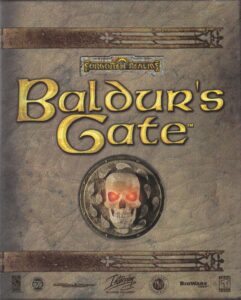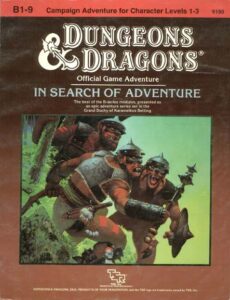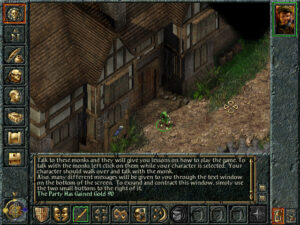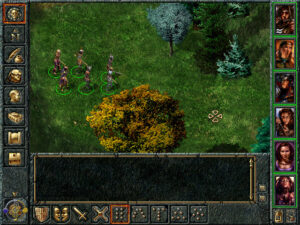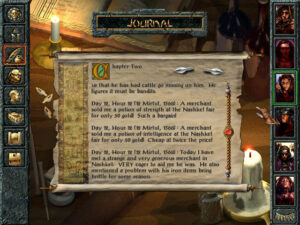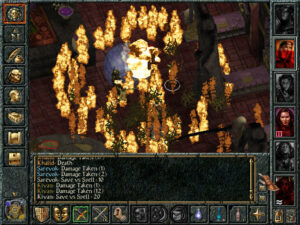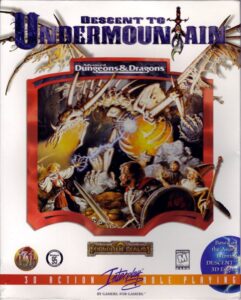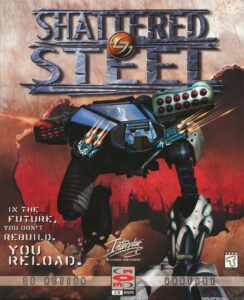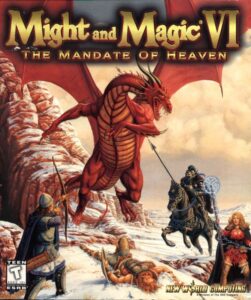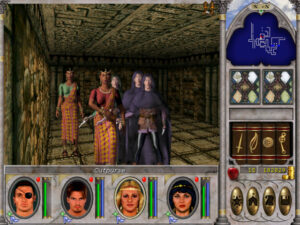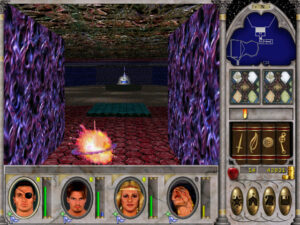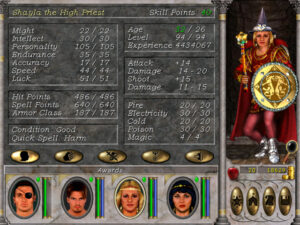The Voyage of Magellan, Chapter 26: Homeward Bound
The CRPG Renaissance, Part 5: Fallout 2 and Baldur’s Gate
As we learned in the earlier articles in this series, Interplay celebrated the Christmas of 1997 with two new CRPGs. One of them, the striking post-apocalyptic exercise called Fallout, was greeted with largely rave reviews. The other, of course, was the far less well-received licensed Dungeons & Dragons game called Descent to Undermountain. The company intended to repeat the pattern in 1998, with another Fallout and another Dungeons & Dragons game. This time, however, the public’s reception of the two efforts would be nearly the polar opposite of last time.
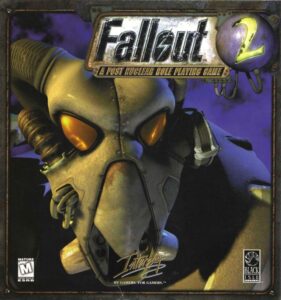
It’s perhaps indicative of the muddled nature of the project that Interplay couldn’t come up with any plot-relevant subtitle for Fallout 2. It’s just another “Post-Nuclear Role-Playing Game.”
Tim Cain claims that he never gave much of a thought to any sequels to Fallout during the three and a half years he spent working on the first game. Brian Fargo, on the other hand, started to think “franchise” as soon as he woke up to Fallout’s commercial potential circa the summer of 1997. Fallout 2 was added to Interplay’s list of active projects a couple of months before the original game even shipped.
Interplay’s sorry shape as a business made the idea of a quick sequel even more appealing than it might otherwise have been. For it should be possible to do it relatively cheaply; the engine and the core rules were already built. It would just be a matter of generating a new story and design, ones that would reuse as many audiovisual assets as possible.
Yet Fargo was not pleased by the initial design proposals that reached his desk. So, just days after Fallout 1 had shipped, he asked Tim Cain to get together with his principal partners Leonard Boyarsky and Jason Anderson and come up with a proposal of their own for the sequel. The three were dismayed by this request; exhausted as they were by months of crunch on Fallout 1, they had anticipated enjoying a relaxing holiday season, not jumping right back into the fray on Fallout 2. Their proposal reflected their mental exhaustion. It spring-boarded off of a joking aside in the original game’s manual, a satirical advertisement which Jason Anderson had drawn up in an afternoon when he was told by Interplay’s printer that there would be an unsightly blank page in the booklet as matters currently stood. The result was the “Garden of Eden Creation Kit”: “When all clear sounds on your radio, you don’t want to be caught without one!” Elaborating on this thin shred of a premise, the sequel would cast you as a descendant of the star of the first game, sent out into the dangerous wastelands to recover one of these Garden of Eden Kits in lieu of a water chip. This apple did not fall far from the tree.
But as it turned out, that suited Brian Fargo just fine. Within a month of Fallout 1′s release, Cain, Boyarsky, and Anderson had been officially assigned to the Fallout 2 project. None of them was terribly happy about it; what all three of them really wanted were a break, a bonus check, and the chance to work on something else, roughly in that order of priority. In January of 1998, feeling under-appreciated and physically incapable of withstanding the solid ten months of crunch that he knew lay before him, Cain turned in his resignation. Boyarsky and Anderson quit the same day in a show of solidarity. (The three would go on to found Troika Studios, whose games we will be meeting in future articles on this site, God willing and the creek don’t rise.)
Following their exodus, Fallout 2 fell to Feargus Urquhart and the rest of his new Black Isle CRPG division to turn into a finished product. Actually, to use the word “division” is to badly overstate Black Isle’s degree of separation from the rest of Interplay. Black Isle was more a marketing label and a polite fiction than a lived reality; the boundaries between it and the mother ship were, shall we say, rather porous. Employees tended to drift back and forth across the border without anyone much noticing.
This was certainly the case for most of those who worked on Fallout 2, a group which came to encompass about a third of the company at one time or another. Returning to the development approach that had yielded Wasteland a decade earlier, Fargo and Urquhart parceled the game out to whoever they thought might have the time to contribute a piece of it. Designer and writer Chris Avellone, who was drafted onto the Fallout 2 team for a few months while he was supposed to be working on another forthcoming CRPG called Planescape: Torment, has little positive to say about the experience: “I do feel like the heart of the team had gone. And all that was left were a bunch of developers working on different aspects of the game like a big patchwork beast. But there wasn’t a good spine or heart to the game. We were just making content as fast as we could. Fallout 2 was a slapdash product without a lot of oversight.”
Still, the programmers did fix some of what annoyed me about Fallout 1, by cleaning up some of the countless little niggles in the interface. Companions were reworked, such that they now behave more or less as you’d expect: they’re no longer so likely to shoot you in the back, are happy to trade items with you, and don’t force you to kill them just to get around them in narrow spaces. Although the game as a whole still strikes me as more clunky and cumbersome than it needs to be — the turn-based combat system is as molasses-slow as ever — the developers clearly did make an effort to unkink as many bottlenecks as they could in the time they had.
But sadly, Fallout 2 is a case of one step forward, one step back: although it’s a modestly smoother-playing game, it lacks its predecessor’s thematic clarity and unified aesthetic vision. Its world is one of disparate parts, slapped together with no rhyme, reason, or editorial oversight. It wants to be funny — always the last resort of a game that lacks the courage of its fictional convictions — but it doesn’t have any surfeit of true wit to hand. It tries to make up for the deficit the same way as many a game of this era, by transgressing boundaries of taste and throwing out lazy references to other pop culture as a substitute for making up its own jokes. This game is very nerdy male, very adolescent-to-twenty-something, and very late 1990s — so much so that anyone who didn’t live through that period as part of the same clique will have trouble figuring out what it’s on about much of the time. I do understand most of the spaghetti it throws at the walls — lucky me! — but that doesn’t keep me from finding it fairly insufferable.
Fallout 2 shipped in October of 1998, just when it was supposed to. But its reception in the gaming press was noticeably more muted than that of its predecessor. Reviewers found it hard to overlook the bugs and glitches that were everywhere, the inevitable result of its rushed and chaotic development cycle, even as the more discerning among them made note of the jarring change in tone and the lack of overall cohesion to the story and design. The game under-performed expectations commercially as well, spending only one week in the American top ten. In the aftermath, Brian Fargo’s would-be CRPG franchise looked like it had already run its course; no serious plans for a Fallout 3 would be mooted at Interplay for quite some time to come.
Yet Fallout 2 did do Interplay’s other big CRPG for that Christmas an ironic service. When BioWare told Fargo that they would like a couple of extra months to finish Baldur’s Gate up properly, the prospect of another Interplay CRPG on store shelves that October made it easier for him to grant their request. So, instead of taking full advantage of the Christmas buying season, Baldur’s Gate didn’t finally ship until a scant four days before the holiday. Never mind: the decision not to ship it before its time paid dividends that some quantity of ephemeral Christmas sales could never have matched. Plenty of gamers proved ready to hand over their holiday cash and gift cards in the days right after Christmas for the most hotly anticipated Dungeons & Dragons computer game since Pool of Radiance. Baldur’s Gate sold 175,000 units before 1998 was over. (Just to put that figure in perspective, this was more copies than Fallout 1 had sold in fifteen months.) Its sales figures would go on to top 1 million units in less than a year, making it the bestselling CRPG to date that wasn’t named Diablo. The cover provided by Fallout 2 helped to ensure that Dr. Muzyka and Dr. Zeschuk would never have to see another patient again.
I’m not someone who places a great deal of sentimental value on physical things. But despite my lack of pack-rattery, some bits of flotsam from my early years have managed to follow me through countless changes of address on both sides of a very big ocean. Playing Baldur’s Gate prompted me to rummage around in the storage room until I came up with one of them. It goes by the name of In Search of Adventure. This rather generically titled little book is, as it says on the front cover, a “campaign adventure” for tabletop Dungeons & Dragons. Note the absence of the “Advanced” prefix; this adventure is for the non-advanced version of the game, the one that was sold in those iconic red and blue boxes that conquered the cafeteria lunch tables of Middle America during the first few years of the 1980s, when TSR dared to dream that their flagship game might become the next Monopoly. If we’re being honest, I always preferred to play this version of the game even after its heyday passed away. It seemed to me more easy-going, more fun-focused, less stuffily, pedantically Gygaxian.
Anyway, the campaign adventure in question came out in 1987, well after my preferred version of Dungeons & Dragons had become the weak sister to its advanced, hardcore sibling — unsurprisingly so, given that pretty much the only people still playing the game by that point were hardcore by definition.
In Search of Adventure is actually a compilation of nine earlier adventure modules that TSR published for beginning-level characters, crammed together into one book with a new stub of a plot to serve as a connecting tissue. I dug it out of storage and have proceeded to talk about it here because it reminds me inordinately of Baldur’s Gate, which works on exactly the same set of principles. There’s an overarching story to it, sure, but it too is mostly just a big grab bag of geography to explore and monsters to fight, in whatever order you prefer. In this sense and many others, it’s defiantly traditionalist. It has more to do with Dungeons & Dragons as it was played around those aforementioned school lunch tables than it does with the avant-garde posturings of TSR’s latter days. As I noted in my last article, the Forgotten Realms in which Baldur’s Gate is set — and in which In Search of Adventure might as well be set, for all that it matters — is so appealing to players precisely because it’s so uninterested in challenging them. The Forgotten Realms is the archetypal place to play Dungeons & Dragons. Likewise, Baldur’s Gate is an archetypal Dungeons & Dragons computer game, the essence of the “a group of adventurers meet in a bar…” school of role-playing. (You really do meet some of your most important companions in Baldur’s Gate in a bar…)
Luke Kristjanson, the BioWare writer responsible for most of the dialog in Baldur’s Gate, says that he never saw the computer game as “a simulation of a fully-realized Medieval world”: “It was a simulation of playing [tabletop] Dungeons & Dragons.” This statement is, I think, the key to understanding where BioWare was coming from and what still makes their game so appealing today, more than a quarter-century on.
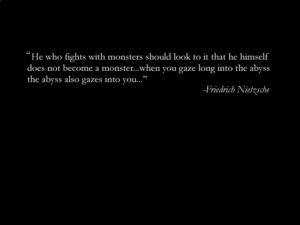
Opening with a Nietzsche quote leads one to fear that Baldur’s Gate is going to try to punch way, way above its weight. Thankfully, it gets the pretentiousness out of its system early and settles down to meat-and-potatoes fare. BioWare’s intention was never, says Luke Kristjanson, to make “a serious fantasy for serious people.” Thank God for that!
But here’s the brilliant twist: in order to conjure up the spirit of those cafeteria gatherings of yore, Baldur’s Gate uses every affordance of late-1990s computer technology that it can lay its hands on. It wants to give you that 1980s vibe, but it wants to do it better — more painlessly, more intuitively, more prettily — than any computer of that decade could possibly have managed. Call it neoclassical digital Dungeons & Dragons.
The game begins in a walled cloister known as Candlekeep, which has a bit of a Name of the Rose vibe, being full of monks who have dedicated their lives to gathering and preserving the world’s knowledge. The character you play is an orphan who has grown up in Candlekeep as the ward of a kindly mage named Gorion. This bucolic opening act gives you the opportunity to learn the ropes, via a tutorial and a few simple, low-stakes quests. But soon enough, a fearsome figure in armor shatters the peace of the cloister, killing Gorion and forcing you to take to the road in search of adventure (to coin a phrase). The game does suggest at the outset that you visit a certain tavern where you might find some useful companions, but it never insists that you do this or anything else. Instead you’re allowed to go wherever you want and to do exactly that thing which pleases you most once you get there. When you do achieve milestones in the main plot, whether deliberately or inadvertently, they’re heralded with onscreen chapter breaks which demonstrate that the story is progressing, because of or despite your antics. In this way, the game tries to create a balance between player freedom and the equally bracing sense of being caught up in an epic plot, one in which you will come to play the pivotal role — being, as you eventually learn, the “Chosen One” who has been marked by destiny. Have I mentioned that Baldur’s Gate is not a game that shirks from fantasy clichés?
Of course, there’s an unavoidable tension between the set-piece plot of the chapter-based structure and the open-world aspect of the game — a tension which we’ve encountered in other games I’ve written about. The main plot is constantly urging you forward, insisting that the fate of the world is at stake and time is of the essence. Meanwhile the many side quests are asking you to rescue a lost housecat or collect wolf pelts for a merchant. If you take the game at its word and rush forward with a sense of urgency, you’ll not only come to the climax under-leveled but will have missed most of the fun. All of which is to say that Baldur’s Gate is best approached like that In Search of Adventure module: just start walking around. Go see what is to be found in those parts of your map that are still blank. Sooner or later, you’ll trigger the next chunk of the main plot anyway.
It’s amazing how enduring some of what is to be found in those blank spaces has proved. My wife likes to read graphic novels. I was surprised recently to see that she’d started on a Dungeons & Dragons-branded one called Days of Endless Adventure, with a copyright date of 2021. I was even more surprised when I flipped it open idly and came face to face with the simple-minded ranger Minsc and his precious pet hamster Boo, both of whom were introduced to the world in Baldur’s Gate.
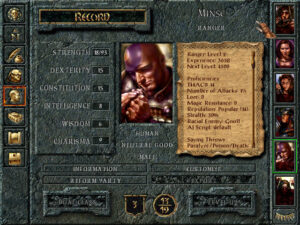
A congenital visual blurriness dogs this game, the result of a little bit too much detail being crammed into a relatively low resolution of 640 X 480, combined with a subdued, brown- and gray-heavy color palette. My middle-aged eyes weren’t always so happy about it, especially when I played on a television in the living room.
As it happened, I had had quite a time with Minsc when I played the game. He joined my party fairly early on, on the condition that we would try to rescue his friend, a magic user named Dynaheir who was being imprisoned in a gnoll stronghold. Unfortunately, I applied the same logic to his principal desire that I did to the main quest line; I’d get to it when I got to it. I maintained this attitude even as he nagged me about it with increasing urgency. One day the dude just flipped out on me, went nuts and started to attack me and my other companions. What’s a person to do in such a situation? Reader, I killed him and his pet hamster.
I was playing a ranger myself, so I didn’t think losing his services would be any big problem. I didn’t notice until days later that killing him — even though, I rush to stipulate again, he attacked me first — had turned me into a “fallen ranger.” I’m told by people who know about such things that this is far from ideal, because it means that you’ve essentially been reduced to the status of a vanilla fighter, albeit one who craves a lot more experience points than usual to advance a level. Oh, well. I didn’t feel like going back so many hours, and I was in more of a “roll with the punches” than a “try and try again” frame of mind anyway. (I’m also told that there will be a way to reverse my fallen condition when I get around to playing Baldur’s Gate II with the same party. So that’s something to look forward to, I guess.) By way of completing the black comedy, I later did rescue Dynaheir and took her into my party. But I was careful not to mention that I had ever met her mysteriously vanished friend…
Any given play-through of Baldur’s Gate is guaranteed to generate dozens of such anecdotes, which combine to make its story your story, even if the text of the chapter breaks is the same for everyone. You don’t have to walk on eggshells, afraid that you’re going to break some necessary piece of plot machinery. Again, it’s you who gets to choose where you go, what you do there, and who travels with you on your quest. Any mistake you make along the way that doesn’t get you and all your friends killed can generally be recovered from or at least lived with, as I did my fallen-ranger status. Tabletop Dungeons & Dragons, says Luke Kristjanson, is about “[being with] your friends [and] doing something fun. And occasionally one’s a jackass and does something weird and you roll with it.” It does seem to me that rolling with it is the only good way to play this second-order simulation of that social experience.
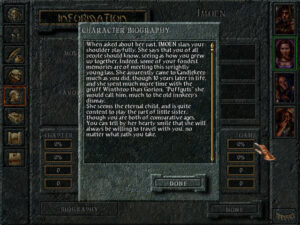
The first companion to join you will probably be Imoen, a spunky female thief. The personalities of your companions are all firmly archetypal, but most of them are likeable enough that it’s hard to complain. Sometimes fantasy comfort food goes down just fine.
Baldur’s Gate’s specific methods of presenting its world of freedom and opportunity have proved as influential as the design philosophies that undergird it. The Infinity Engine provided the presentational blueprint for a whole school of CRPGs that are still with us to this day. You look down on the environment and the characters in it from a free-scrolling isometric point of view. You can move the “camera” anywhere you like in the current area, independent of the locations of your characters. That said, a fog-of-war is implemented: places your characters have not yet seen are completely blacked out, and you can’t know what other people or monsters are getting up to if they’re out of your characters’ line of sight.
The interface proper surrounds this view on three sides. Portraits of the members of your party — up to five of them, in addition to the character you create and embody from the outset — run down the right side of the screen. Command icons — some pertaining to the individual party members and some to the group as a whole or to the computer on which you’re running the game — stretch across the left side and bottom of the screen. An area just above the bottom line of icons can expand to display text, of which there is an awful lot in this game, mostly in the form of menu-driven conversations. (In 1998, we were still far from the era when it would be practical and cost-effective to have full voice-acting in a game with this much yammering. Instead just the occasional line of dialog is voiced, to establish personalities and set tones.) The interface is perhaps a bit more obscure and initially daunting than it might be in a modern game, but the contrast with the old keyboard-driven SSI Gold Box games could hardly be more stark. And thankfully, unlike Fallout’s, Baldur’s Gate’s interface doesn’t make the mistake of prioritizing aesthetics over utility.
In short, Baldur’s Gate tries really, really hard to be approachable in the way that modern players have come to expect, even if it doesn’t always make it all the way there. Take, for instance, its journal, an exhaustive chronicle of the personal story that you are generating as you play. That’s great. But what’s less great is that it can be inordinately difficult to sift through the huge mass of text to find the details of a quest you’re pretty sure you accepted sometime last week. Most of us would love to have a simple bullet list of quests to go along with the verbose diary, however much that may cause the hardcore immersion-seekers to howl in protest at the gameyness of it all. Later Infinity Engine games corrected oversights like this one.
The most oft-discussed and controversial aspect of the Infinity Engine, back in the day and to some extent even today, is its implementation of combat. As we’ve learned, makers of CRPGs in the late 1990s faced a real conundrum when it came to combat. They wanted to preserve a measure of tactical complexity, but they also had to reckon with the reality of a marketplace that showed a clear preference for fast-paced, fluid gameplay over turn-based models. Fallout tried to square that circle by running in real-time until a fight began, at which point it forced you back into a turn-based framework; Might and Magic VI did a little better in my opinion by letting you decide when you wanted to go turn-based. In a way, BioWare was even more constrained than the designers of either of those two games, because they were explicitly making a digital implementation of a turn-based set of tabletop rules.
Their solution to the conundrum was real-time-with-pause, in which the computer automatically acts out the combat, adhering to the rules of tabletop Dungeons & Dragons but, critically, without advertising the breaks between rounds and turns. The player can assert her will at any point in the proceedings by tapping the space bar to pause the action, issuing new commands to her charges, and then tapping it again to let the battle resume.
Clever though the scheme is, not everyone loves it. And, to be sure, there are valid complaints to levy against it. Big fights can all too quickly degenerate into a blob of intersecting sprites, with spells going off everywhere and everyone screaming at once; it’s like watching twenty Tasmanian Devils — the Looney Tunes version, that is — in a fur-flying free-for-all. Yet there are ways to alleviate the confusion by making judicious use of the option to “auto-pause,” a hugely important capability that is mentioned only in oblique passing in the game’s 160-page manual, presumably because that document was sent to the printing press before the software it described had been finalized. Auto-pause will let you stop the action automatically whenever certain conditions of your choice are met — or even at the end of every single action taken by every single member of your party, if you choose to go that far. Doing so lets you effectively turn Baldur’s Gate into a purely turn-based game, if that’s your preference. Or you can go fully turn-based only for the really big fights that you know will require careful micro-management. This is what I do. The rest of the time, I just use a few judicious break points — a character is critically wounded, a spell caster has finished casting a spell, etc. — and otherwise rely on the good old space bar.
Another option — the best one for those most determined to turn the game into a simulation of playing tabletop Dungeons & Dragons with your mates — is to turn on artificial intelligence for every member of your party but the one you created. Then you just let them all do their things while you do yours. You may find yourself less enamored with this approach, however, after you become part of the collateral damage of one of Dynaheir’s Fireball spells for the first time. (Shades of the stone-stupid and deadly companions in Fallout…)
Baldur’s Gate’s combat definitely isn’t perfect, but in its day it was a good-faith attempt to deliver an experience that was recognizably Dungeons & Dragons while also catering to the demands of the contemporary marketplace. I think it holds up okay today, especially when placed in the context of the rest of the game that houses it, which has ambitions for its world and its fiction that transcend the tactical-combat simulations that the latter-day Gold Box games especially lapsed into. It is true that your companions’ artificial intelligence could be better, as it is true that it’s sometimes harder than it ought to be to figure out what’s really going on, a byproduct of graphics that are somewhat muddy even at the best of times and of having way too many character sprites in way too small a space. But your fighters, who don’t usually require too much micro-management, are the most affected by this latter problem, while your spell casters ought to be standing well back from the fray anyway, if they know what’s good for them. Another not-terrible approach, then, is to control your spell casters yourself, since they’re the ones who can most easily ruin their companions’ day, and leave your fighters to their own devices. But you’ll doubtless figure out what works best for you within the first few hours.
Indeed, Baldur’s Gate feels disarmingly modern in the way that it bends over backward to adjust itself to your preferred style of play. This encompasses not only the myriad of auto-pause and artificial-intelligence options but an adjustable global difficulty slider for combat. All of this allows you to breeze through the fights with minimal effort or hunker down for a long series of intricate tactical struggles, just as you choose. Giving your player as many ways to play as possible is seldom a bad choice in commercial game design. Not everyone had yet figured that out in the late 1990s.
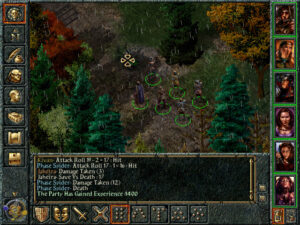
If you want the ultimate simulation of playing tabletop Dungeons & Dragons with your friends, you can turn on an option to watch the actual die rolls scrolling past during combat.
BioWare and Interplay released an expansion pack to Baldur’s Gate called Tales of the Sword Coast just six months after the base game. Rather than serving as a sequel to the main plot, it’s content merely to add some new ancillary areas to explore betwixt and between fulfilling your destiny as The Chosen One. Given that I definitely don’t consider the main plot the most interesting part of Baldur’s Gate, I have no problem with this approach in theory. Nevertheless, the expansion pack strikes me as underwhelming and kind of superfluous — like a collection of all the leftover bits that failed to make the cut the first time around, which I suspect is exactly what it is. The biggest addition is an elaborate dungeon known as Durlag’s Tower, created to partially address one of the principal ironies of the base game: the fact that it contains surprisingly little in the way of dungeons and no dragons whatsoever. The latter failing would have to wait for the proper sequel to be corrected, but BioWare did try to shore up the former aspect by presenting an old-school, tactically complex dungeon crawl of the sort that Gary Gygax would have loved, a maze rife not only with tough monsters but with secret doors, illusions, traps, and all manner of other subtle trickery. Personally, I tend to find this sort of thing more tedious than exciting at this stage of my life, at least when it’s implemented in this particular game engine. I decided pretty quickly after venturing inside to let old Durlag keep his tower, since he seemed to be having a much better time there than I was.
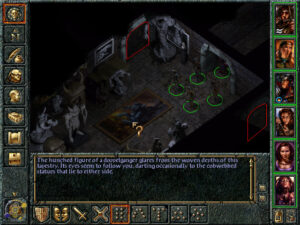
Durlag’s Tower. The Infinity Engine doesn’t do so well in such narrow, trap-filled spaces. It’s hard to keep your characters from blundering into places that they shouldn’t.
While your reaction to the über-dungeon may be a matter of taste, a more objective ground for concern is all of the new sources of experience points the expansion adds, whilst raising the experience and level caps on your characters only modestly. As a result, it becomes that much easier to max out your characters before you finish the game, a state of affairs which is no fun at all. In my eyes, then, Baldur’s Gate is a better, tighter game without the expansion. For better or for worse, though, Tales of the Sword Coast has become impossible to extricate from the base game, being automatically incorporated into all of the modern downloadable editions. So, I’ll content myself with telling you to feel free to skip Durlag’s Tower and/or any of the other additional content if it’s not your thing. There’s nothing essential to the rest of the game to be found there.
Whatever its infelicities and niggles, it’s almost impossible to overstate the importance and influence of Baldur’s Gate in the broader context of gaming history. Forget the comparisons I’ve been making again and again in these articles to Pool of Radiance: one can actually make a case for Baldur’s Gate as the most important single-player CRPG released between 1981, the landmark year of the first Wizardry and Ultima, and the date of this very article that you’re reading.
Baldur’s Gate’s unprecedented level of commercial success transformed the intersection between tabletop Dungeons & Dragons and its digital incarnations from a one-way avenue into a two-way street; all of the future editions of the tabletop rules that would emerge under Wizards of the Coast’s watch would be explicitly crafted with an eye to what worked on the computer as well. At the same time, Baldur’s Gate cemented one of the more enduring abstract design templates in digital gaming history; witness the extraordinary success of 2023’s belated Baldur’s Gate 3. The CRPGs that more immediately followed Baldur’s Gate I, both those that were powered by the Infinity Engine and those that only borrowed some of its ideas, found ways to improve on the template in countless granular details, but they were all equally the heirs to this very first Infinity Engine game. Yes, Fallout got there first, and in some respects did it even better, with a less clichéd, more striking setting and an even deeper-seated commitment to acknowledging and responding to its player’s choices. And there’s more than a little something to be said for the role played by the goofy, janky, uninhibited Monty Haul fun of Might and Magic VI in the rehabilitation of the CRPG genre as well. Yet the fact remains that it was Baldur’s Gate that truly led the big, meaty CRPG out of the wilderness and back into the mainstream.
Then again, gaming history is not a zero-sum game. The note on which I’d prefer to end this series of articles is simply that the CRPG genre was back by 1999. Increasingly, it would be the computer games that drove sales of tabletop Dungeons & Dragons rather than the other way around. Meanwhile a whole lot of other CRPGs, including some of the most interesting ones of all, would be given permission to blaze their own trails without benefit of a license. I look forward to visiting or revisiting some of them with you in the years to come, as we explore this genre’s second golden age.
Did you enjoy this article? If so, please think about pitching in to help me make many more like it. You can pledge any amount you like.
Sources: For Baldur’s Gate, see my last article, with the addition of the book BioWare: Stories and Secrets from 25 Years of Game Development, which commenter Infinitron was kind enough to tell me about.
For Fallout 2: the book Beneath a Starless Sky: Pillars of Eternity and the Infinity Engine Era of RPGs by David L. Craddock. Computer Gaming World of February 1999; Retro Gamer 72 and 188. Also Chris Avellone’s appearance on Soren Johnson’s Designer Notes podcast and Tim Cain’s YouTube channel.
Where to Get Them: Fallout 2 and Baldur’s Gate are both available as digital purchases at GOG.com, the latter in an “enhanced edition” that sports some welcome quality-of-life improvements alongside some additional characters and quests that don’t sit as well with everyone. Note that it buying it does give you access to the original game as well.
The CRPG Renaissance, Part 4: …Long Live Dungeons & Dragons!
In December of 1997, Interplay Entertainment released Descent to Undermountain, the latest licensed Dungeons & Dragons computer game. It’s remembered today, to whatever extent it’s remembered at all, as one of the more infamous turkeys of an era with more than its share of over-hyped and half-baked creations, a fiasco almost on par with Battlecruiser 3000AD or Daikatana. The game was predicated on the dodgy premise that Dungeons & Dragons would make a good fit with the engine from Descent, Interplay’s last world-beating hit — and also a hit that was, rather distressingly for Brian Fargo and his colleagues, more than two years in the past by this point.
Simply put, Undermountain was a mess, the kind of career-killing disaster that no self-respecting game developer wants on his CV. The graphics, which had been crudely up-scaled from the absurdly low resolution of 320 X 240 to a slightly more respectable 640 X 480 at the last minute, still didn’t look notably better than those of the five-year-old Ultima Underworld. The physics were weirdly floaty and disembodied, perhaps because the engine had been designed without any innate notion of gravity; rats could occasionally fly, while the corpses of bats continued to hover in midair long after shaking off their mortal coil. In design terms as well, Undermountain was trite and rote, just another dungeon crawl in the decade-old tradition of Dungeon Master, albeit not executed nearly so well as that venerable classic.
Computer Gaming World, hot on the heels of giving a demo of Undermountain a splashy, breathless write-up (“This game looks like a winner…”), couldn’t even muster up the heart to print a proper review of the underwhelming finished product. The six-sentence blurb the magazine did deign to publish said little more than that “the search for a good Dungeons & Dragons role-playing game continues, because Descent to Undermountain is certainly not it.” The website GameSpot was less inclined to pull its punches: after running through a damning litany of the game’s problems, it told its readers bluntly that “if you buy Descent to Undermountain after reading this, you get what you deserve.” The critical consensus has not changed over the decades since. On the clearinghouse site MobyGames, Undermountain ranks today as the thirteenth worst digital RPG ever released, out of 9085 candidates in all. Back in 1997, reviewers and gamers alike marveled that Interplay, the same company that had released the groundbreaking and aesthetically striking Fallout just weeks earlier, could follow it up so quickly with something so awful.
In its way, then, Descent to Undermountain‘s name was accidentally appropriate. For it represented the absolute nadir of Dungeons & Dragons on computers, the depth of ignominy to which all of the cookie-cutter products from SSI and others had been inexorably descending over the last five years.
Then again, as a wise person once said, there does come a point where there’s nowhere left to go but up. Less than one year after Undermountain was so roundly scorned wherever it wasn’t ignored, another Dungeons & Dragons CRPG was released amidst an atmosphere of excitement and expectation that put even the reception of Pool of Radiance to shame. Almost as surprisingly, it too bore on its box the name of Interplay, a publisher whose highs and lows in the CRPG genre were equally without parallel. So, our goal for today is to understand how Interplay went from Descent to Undermountain to Baldur’s Gate. It’s an unlikely tale in the extreme, not least in the place and manner in which it begins.
Edmonton, Alberta, is no one’s idea of a high-tech incubator. “The Gateway to the North,” as the city styles itself, was built on oil and farming. These two things have remained core to its identity, alongside its beloved Edmonton Oilers hockey team and its somewhat less beloved but stoically tolerated sub-zero winter temperatures. The frontier ethic has never entirely left Edmonton; it has more in common with Billings, Montana, than it does with coastal Canadian cities like Montreal and Vancouver.
Into this milieu, insert three young men who were neither roughnecks nor farmers. Ray Muzyka, Greg Zeschuk, and Augustine Yip didn’t know one another when they were growing up in different quarters of Edmonton in the 1980s, but they were already possessed of some noteworthy similarities. Although all three had computers in their homes and enjoyed experimenting with the machines and the games they could play from an early age — Muzyka has recorded his first two games ever as Pirate Adventure and Wizardry on the Apple II — they directed their main energies toward getting into medical school and becoming doctors. “We never conceived of the possibility that you could have a career in videogames,” says Zeschuk. “You know, we’re from Edmonton, Canada. There were no companies that did that. There were some in Vancouver, but they were just starting out, like the Distinctive Software guys who would join Electronic Arts.”
The three men finally met in medical school — more specifically, at the University of Alberta during the late 1980s. Even here, though, they didn’t become fast friends right away. Only gradually did they come to realize that they had a set of shared interests that were anything but commonplace among their classmates: all three continued to play computer games avidly whenever the pressure of their studies allowed it. Witnessing the rapid evolution of personal computers, each began to ask himself whether he might be able to combine medicine with the technology in some satisfying and potentially profitable way. Then they began to have these conversations with each other. It seemed to them that there were huge opportunities in software for educating doctors. Already in 1990, a couple of years before they graduated from medical school, they started looking for technology projects as moonlighting gigs.
They kept at it after they graduated and became family practitioners. The projects got more complex, and they hired contractors to help them out. Their two most ambitious software creations were an “Acid-Base Simulator,” which they finished in 1994, and a “Gastroenterology Patient Simulator,” which they finished the following year. As their titles will attest, these products were a long, long way from a mainstream computer game, but the good doctors would cover the intervening distance with astonishing speed.
Wanting to set themselves on a firmer professional footing in software, Muzyka, Zeschuk, and Yip founded a proper corporation on February 1, 1995. They called it BioWare, a name that reflected a certain amount of bets-hedging. On the one hand, “BioWare” sounded fine as a name for a maker of medical software like the gastroenterology simulator they were still finishing up. On the other, they thought it was just catchy and all-purpose enough to let them branch out into other sorts of products, if doing so should prove feasible. In particular, they had become very interested in testing the waters of mainstream game development. “I liked medicine a lot,” says Muzyka. “I really liked it. I’m glad I was able to help people’s lives for the years that I did practice. I did a lot of emergency medicine in under-served areas in rural Alberta. It was really hard work, but really fun, really engaging, really exciting. [But] I love videogames.”
Their medical degrees were a safety net of a sort that most first-time entrepreneurs could only wish they had; they knew they could always go back to doctoring full-time if BioWare didn’t work out. “We maxed out our debt and our credit cards,” Muzyka says. “We just kind of went for it. It was like, whatever it took, this is what we’re doing. It never occurred to us [that] there would be risk in that. For me, it was a fun hobby at that point.”
Yet some differences soon became apparent between Muzyka and Zeschuk and their third partner Augustine Yip. Although the first two were willing and able to practice medicine only on the side while they devoted more and more time and energy to BioWare, the last had moved into another stage of life. He already had children to support, and didn’t feel he could scale back his medical career to the same degree for this other, far chancier venture. Muzyka and Zeschuk would wind up buying out his share of BioWare in mid-1996.
Well before this event, in the spring of 1995, Activision’s MechWarrior 2: 31st Century Combat hit the gaming world with all the force of the giant killer robot on its box. Thanks not least to Activision’s work in creating bespoke versions of MechWarrior 2 for the many incompatible 3D-accelerator cards that appeared that year, it became by many metrics the game of 1995. Suddenly every publisher wanted a giant-mech game of their own. Muzyka and Zeschuk saw the craze as their most surefire on-ramp to the industry as a new, unproven studio without even an office to their name. They paid a few contractors to help them make a demo, sent it to ten publishers, and started cold-calling them one after another. Their secret weapon, says Muzyka, was “sheer stubbornness and persistence. We just kept calling.” Amazingly, they were eventually offered a development deal by nine out of the ten publishers; suffice to say that mechs were very much in favor that year. Interplay came with the most favorable terms, so the partners signed with them. Just like that, BioWare was a real games studio. Now they had to deliver a real game.
They found themselves some cut-price office space not far from the University of Alberta. Ray Muzyka:
There were only four plugs on the wall. We had a power-up sequence for the computers in the office so that we didn’t blow the circuit breaker for the whole building. Everybody would be like, “I’m on. I’m on. I’m on.” We had found by trial and error that if you turned them on in a certain order, it wouldn’t create a power overload. If you turned on the computers in the wrong order, for sure, it would just flip the switch and you had to run downstairs, get the key, and open up the electrical box. It was an interesting space.
During the first year or so, about a dozen employees worked in the office in addition to the founders. Half of these were the folks who had helped to put together the demo that had won BioWare the contract with Interplay. The other half were a group of friends who had until recently hung out together at a comic-book and tabletop-gaming shop in Grande Prairie, Alberta, some 300 miles northwest of Edmonton; one of their number, a fellow named James Ohlen, actually owned the store. This group had vague dreams of making a CRPG; they tinkered around with designs and code there in the basement. Unfortunately, the shop wasn’t doing very well. Even in the heyday of Magic: The Gathering, it was difficult to keep such a niche boutique solvent in a prairie town of just 30,000 people. Having heard about BioWare through a friend of a friend, the basement gang all applied for jobs there, and Muzyka and Zeschuk hired them en masse. So, they all came down to Edmonton, adopting various shared living arrangements in the cheap student-friendly housing that surrounded the university. Although they would have to make the mech game first, they were promised that there was nothing precluding Bioware from making the CRPG of their dreams at some point down the road if this initial project went well.
Shattered Steel, BioWare’s first and most atypical game ever, was published by Interplay in October of 1996. It was not greeted as a sign that any major new talent had entered the industry. It wasn’t terrible; it just wasn’t all that good. Damning it with faint praise, Computer Gaming World called it “a decent first effort. But if Interplay wants to provide serious competition for the MechWarrior series, the company needs to provide more freedom and variety.” Sales hovered in the low tens of thousands of units. That wasn’t nothing, but BioWare’s next game would need to do considerably better if they were to stay in business. Luckily, they already had something in the offing that seemed to have a lot of potential.
A BioWare programmer named Scott Greig had been tinkering lately with a third-person, isometric, real-time graphics engine of his own devising. He called it the Infinity Engine. Muzyka and Zeschuk had an idea about what they might use it for.
A low background hum was just beginning to build about the possibilities for a whole new sort of CRPG, where hundreds or thousands of people could play together in a shared persistent world, thanks to the magic of the Internet. 3DO’s Meridian 59, the first of the new breed, was officially open for business already, even as Sierra’s The Realm was in beta and Origin’s Ultima Online, the most ambitious of the shared virtual worlds by far, was gearing up for its first large-scale public test. Muzyka and Zeschuk, who prided themselves on keeping up with the latest trends in gaming, saw an opportunity here. Even before Shattered Steel shipped, it had been fairly clear to them that they had jumped on the MechWarrior train just a little bit too late. Perhaps they could do better with this nascent genre-in-the-offing, which looked likely to be more enduring than a passing fancy for giant robots.
They decided to show the Infinity Engine to their friends at Interplay, accompanied by the suggestion that it might be well-suited for powering an Ultima Online competitor. They booked a meeting with one Feargus Urquhart, who had started at Interplay six years earlier as a humble tester and moved up through the ranks with alacrity to become a producer while still in his mid-twenties. Urquhart was skeptical of these massively-multiplayer schemes, which struck him as a bit too far out in front of the state of the nation’s telecommunications infrastructure. When he saw the Infinity Engine, he thought it would make a great fit for a more traditional style of CRPG. Further, he knew well that the Dungeons & Dragons brand was currently selling at a discount. Muzyka and Zeschuk, who were looking for any way at all to get their studio established well enough that they could stop taking weekend shifts at local clinics, were happy to let Urquhart pitch the Infinity Engine to his colleagues in this other context.
Said colleagues were for the most part less enthused than Urquhart was; as we’ve learned all too well by now, the single-player CRPG wasn’t exactly thriving circa 1996. Nor was the Dungeons & Dragons name on a computer game any guarantee of better sales than the norm in these latter days of TSR. Yet Urquhart felt strongly that the brand was less worthless than mismanaged. There had been a lot of Dungeons & Dragons computer games in recent years — way too many of them from any intelligent marketer’s point of view — but they had almost all presumed that what their potential buyers wanted was novelty: novel approaches, novel mechanics, novel settings. As they had pursued those goals, they had drifted further and further from the core appeal of the tabletop game.
Despite TSR’s fire hose of strikingly original, sometimes borderline avant-garde boxed settings, the most popular world by far in which to actually play tabletop Dungeons & Dragons remained the Forgotten Realms, an unchallenging mishmash of classic epic-fantasy tropes. The Forgotten Realms was widely and stridently criticized by the leading edge of the hobby for being fantasy-by-the-numbers, and such criticisms were amply justified in the abstract. But those making them failed to reckon with the reality that, for most of the people who still played tabletop Dungeons & Dragons, it wasn’t so much a vehicle for improvisational thespians to explore the farthest realms of the imagination as it was a cozy exercise in dungeon delving and monster bashing among friends; the essence of the game was right there in its name. For better or for worse, most people still preferred good old orcs and kobolds to the mind-bending extra-dimensional inhabitants of a setting like Planescape or the weird Buck Rogers vibe of something like Spelljammer. The Forgotten Realms were gaming comfort food, a heaping dish of tropey, predictable fun. And the people who played there wouldn’t have had it any other way.
And yet fewer and fewer Dungeons & Dragons computer games had been set in the Forgotten Realms since the end of the Gold Box line. (Descent to Undermountain would be set there, but it had too many other problems for that to do it much good.) SSI and their successors had also showed less and less fidelity to the actual rules of Dungeons & Dragons over the years. The name had become nothing more than a brand, to be applied willy-nilly to whatever struck a publisher’s fancy: action games, real-time-strategy games, you name it. In no real sense were you playing TSR’s game of Dungeons & Dragons when you played one of these computer games; their designers had made no attempt to implement the actual rules found in the Player’s Handbook and Dungeons Master’s Guide. It wasn’t clear anymore what the brand was even meant to stand for. It had been diluted to the verge of meaninglessness.
But Feargus Urquhart was convinced that it was not yet beyond salvation. In fact, he believed that the market was ready for a neoclassical Dungeons & Dragons CRPG, if you will: a digital game that earnestly strove to implement the rules and to recreate the experience of playing its tabletop inspiration, in the same way that the Gold Box line had done. Naturally, such a game would need to take place in the tried-and-true Forgotten Realms. This was not the time to try to push gamers out of their comfort zone.
At the same time, though, Urquhart recognized that it wouldn’t do to simply re-implement the Gold Box engine and call it a day. Computer gaming had moved on from the late 1980s; people expected a certain level of audiovisual razzle-dazzle, wanted intuitive and transparent interfaces that didn’t require reading a manual to learn how to use, and generally preferred the fast-paced immediacy of real-time to turn-based models. If it was to avoid seeming like a relic from another age, the new CRPG would have to walk a thin line, remaining conservative in spirit but embracing innovation with gusto in all of its granular approaches. The ultimate goal would not be to recreate the Gold Box experience. It must rather be to recreate the same tabletop Dungeons & Dragons experience that the Gold Box games had pursued, but to embrace all of the affordances of late-1990s computers in order to do it even better — more accurately, more enjoyably, with far less friction. Enter the Infinity Engine.
But Urquhart’s gut feeling was about more than just a cool piece of technology. He had served as the producer on Shattered Steel, in which role he had visited BioWare several times and spent a fair amount of time with the people there. Thus he knew there were people in that Edmonton office who still played tabletop Dungeons & Dragons regularly, who had forged their friendships in the basement of a tabletop-gaming shop. He thought that a traditionalist CRPG like the one he had in mind might be more in their wheelhouse than any giant-robot action game or cutting-edge shared virtual world.
He felt this so strongly that he arranged a meeting with Brian Fargo, the Big Boss himself, whose soft spot for the genre that had put Interplay on the map a decade earlier was well known. When he was shown the Infinity Engine, Fargo’s reaction was everything Urquhart had hoped it would be. What sprang to his mind first was The Faery Tale Adventure, an old Amiga game whose aesthetics he had always admired. “It didn’t look like a bunch of building blocks,” says Fargo today of the engine that Urquhart showed him in 1996. “It looked like somebody had free-hand-drawn every single screen.”
As Urquhart had anticipated would be the case, it wasn’t hard for Fargo to secure a license from the drowning TSR to make yet another computer game with the name of Dungeons & Dragons on it. The bean counters on his staff were not excited at the prospect; they didn’t hesitate to point out that Interplay already had Fallout and Descent to Undermountain in development. Just how many titles did they need in such a moribund genre? They needed at least one more, insisted Fargo.
BioWare’s employees were astonished and overjoyed when they were informed that a chance to work on a Dungeons & Dragons CRPG had fallen into their laps out of the clear blue sky. James Ohlen and his little gang from Grande Prairie could scarcely have imagined a project more congenial to their sensibilities. Ohlen had been running tabletop Dungeons & Dragons campaigns for his friends since he was barely ten years old. Now he was to be given the chance to invent one on the computer, one that could be enjoyed by the whole world. It was as obvious to Urquhart as it was to everyone at BioWare that the title of Lead Designer must be his. He called his initial design document The Iron Throne. When a cascade of toilet jokes rained down on his head in response, Urquhart suggested the more distinctive name of Baldur’s Gate, after the city in the Forgotten Realms where its plot line would come to a climax.
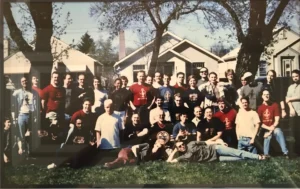
The staff of BioWare, circa 1997. (Note the Edmonton Oilers jersey at front and center.) “It’s 38 kids I barely recognize, myself included,” says Lukas Kristjanson, who along with James Ohlen wrote most of the text in the game. “I look at that face and think, ‘Man, you did not know what you were doing.'”
BioWare eagerly embraced Urquhart’s philosophy of being traditionalist in spirit but modern in execution. The poster child for the ethic must surely be Baldur’s Gate’s approach to combat. BioWare faithfully implemented almost every detail of the Advanced Dungeons & Dragons rules, complete with all of the less intuitive legacies of Gary Gygax, such as the armor-class statistic that goes down rather than up as it gets better. But, knowing that a purely turn-based system would be a very hard sell in the current market, they adopted a method of implementing them that became known as “real-time-with-pause.” Like much in Baldur’s Gate, it was borrowed from another game, a relatively obscure 1992 CRPG called Darklands, which was unique for being set in Medieval Germany rather than a made-up fantasy world.
Real-time-with-pause means that, although the usual tabletop rounds and turns are going on in the background, along with the expected initiative rolls and to-hit rolls and all the rest, it all takes place seamlessly on the computer — that’s to say, without pausing between turns, unless and until the player stops the action manually to issue new orders to her party. James Ohlen:
Ray [Muzyka] was a big fan of turn-based games, the Gold Box games, and my favorite genre was real-time strategy; I played Warcraft and Starcraft more than you can imagine. So, [real-time-with-pause] came from having to have a real-time game that satisfied fans of that genre, but also satisfied turn-based fans. Maybe I shouldn’t say it, but I was never a fan of Fallout. I liked the story and the world, but the fact it paused and took turns for moving, I never liked that. RPGs are about immersing you in their world, so the closer you get to the feeling of real the better.
The project was still in its earliest stages when Diablo dropped. “I remember when Diablo came out, the whole office shut down for a week,” says James Ohlen. Needless to say, many another games studio could tell the same tale.
The popularity of Blizzard Entertainment’s game was the first really positive sign for the CRPG genre as a whole in several years. In this sense, it was a validation for Baldur’s Gate, but it was also a risk. On a superficial level, the Diablo engine didn’t look that different from the Infinity Engine; both displayed free-scrolling, real-time environments from an isometric point of view. Blizzard’s game, however, was so simplified and streamlined that it prompted endless screaming rows on the Internet over whether it ought to qualify as a “real” CRPG at all. There was certainly no real-time-with-pause compromise in evidence here; Diablo was real-time, full stop. Given its massive success, someone at Interplay or BioWare — or more likely both — must surely have mused about dropping most of the old-school complexity from Baldur’s Gate and adopting Diablo as the new paradigm; the Infinity Engine would have been perfectly capable of bringing that off. But, rather remarkably on the face of it, no serious pressure was ever brought to bear in that direction. Baldur’s Gate would hew faithfully to its heavier, more traditionalist vision of itself, even as the people who were making it were happily blowing off steam in Diablo. The one place where Diablo did clearly influence Baldur’s Gate was a networked multiplayer mode that was added quite late in the development cycle, allowing up to six people to play the game together. Although BioWare deserves some kudos for managing to make that work at all, it remains an awkward fit with such a text- and exposition-heavy game as this one.
As James Ohlen mentions above, the BioWare folks were playing a lot of Blizzard’s Warcraft II as well, and borrowing freely from it whenever it seemed appropriate. Anyone who has played a real-time-strategy game from the era will see many traces of that genre in Baldur’s Gate: the isometric graphics, the icons running around the edges of the main display, your ability to scroll the view independently of the characters you control, even the way that active characters are highlighted with colored circles. The Infinity Engine could probably have powered a fine RTS game as well, if BioWare had chosen to go that route.
Even more so than most games, then, Baldur’s Gate was an amalgamation of influences, borrowing equally from James Ohlen’s long-running tabletop Dungeons & Dragons campaign and the latest hit computer games, along with older CRPGs ranging from Pool of Radiance to Darklands. I hate to use the critic’s cliché of “more than the sum of its parts,” but in this case it may be unavoidable. “If you’re a Dungeons & Dragons fan, you feel like you’re playing Dungeons & Dragons, but at the same time it felt like a modern game,” says James Ohlen. “It was comparable to Warcraft and Diablo in terms of the smoothness of the interface, the responsiveness.”
Baldur’s Gate started to receive significant press coverage well over a year before its eventual release in December of 1998. Right from the first previews, there was a sense that this Dungeons & Dragons computer game was different from all of the others of recent years; there was a sense that this game mattered, that it was an event. The feeling was in keeping with — and to some extent fed off of — the buzz around Wizards of the Coast’s acquisition of TSR, which held out the prospect of a rebirth for a style of play that tabletop gamers may not have fully recognized how much they’d missed. Magic: The Gathering was all well and good, but at some point its zero-sum duels must begin to wear a little thin. A portion of tabletop gamers were feeling the first inklings of a desire to return to shared adventures over a long afternoon or evening, adventures in which everyone got to win or lose together and nobody had to go home feeling angry or disappointed.
A similar sentiment was perhaps taking hold among some digital gamers: a feeling that, for all that Diablo could be hella fun when you didn’t feel like thinking too much, a CRPG with a bit more meat on its bones might not go amiss. Witness the relative success of Fallout in late 1997 and early 1998; it wasn’t a hit on the order of Diablo, no, but it was a solid seller just the same. Even the miserable fiasco that was Descent to Undermountain wasn’t enough to quell the swelling enthusiasm around Baldur’s Gate. Partially to ensure that nothing like Undermountain could happen again, Brian Fargo set up a new division at Interplay to specialize in CRPGs. He placed it in the care of Feargus Urquhart, who named the division and the label Black Isle, after the Black Isle Peninsula in his homeland of Scotland.
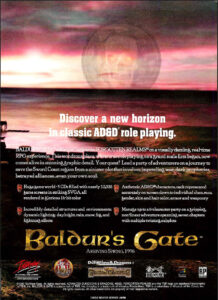
Interplay was already running full-page advertisements like this one in the major magazines before 1997 was out. Note the emphasis on “true role-playing on a grand scale” — i.e., not like that other game everyone was playing, the one called Diablo.
The buzz around Baldur’s Gate continued to build through 1998, even as a planned spring release was pushed back to the very end of the year. A game whose initial sales projections had been on the order of 100,000 units at the outside was taking on more and more importance inside the executive suites at Interplay. For the fact was that Interplay as a whole wasn’t doing very well — not doing very well at all. Brian Fargo’s strategy of scatter-bombing the market with wildly diverse products, hoping to hit the zeitgeist in its sweet spot with at least a few of them, was no longer paying off for him. As I mentioned at the opening of this article, Interplay’s last real hit at this stage had been Descent in 1995. Not coincidentally, that had also been their last profitable year. The river of red ink for 1998 would add up to almost $30 million, a figure one-quarter the size of the company’s total annual revenues. In October of 1998, Fargo cut about 10 percent of Interplay’s staff, amounting to some 50 people. (Most of them had been working on Star Trek: The Secret of Vulcan Fury, a modernized follow-up to the company’s classic Star Trek: 25th Anniversary and Judgment Rites adventure games. Its demise is still lamented in some corners of Star Trek and gaming fandom.)
Fargo was increasingly seeing Baldur’s Gate as his Hail Mary. If the game did as well as the buzz said it might, it would not be able to rescue his sinking ship on its own, but it would serve as much-needed evidence that Interplay hadn’t completely lost its mojo as its chief executive pursued his only real hope of getting out of his fix: finding someone willing to buy the company. The parallels with the sinking ship that had so recently been TSR doubtless went unremarked by Fargo, but are nonetheless ironically notable.
BioWare’s future as well was riding on what was destined to be just their second finished game. The studio in the hinterlands had grown from 15 to 50 people over Baldur’s Gate’s two-year development cycle, leaving behind as it did so its electrically-challenged hovel of an office for bigger, modestly more respectable-looking digs. Yet appearances can be deceiving; BioWare was still an unproven, unprofitable studio that needed its second game to be a hit if it was ever to make a third one. It was make-or-break-time for everyone, not least Ray Muzyka and Greg Zeschuk. If Baldur’s Gate was a hit, they might never have to take up their stethoscopes again. And if it wasn’t… well, they supposed it would be back to the clinic for them, with nothing to show for their foray into game development beyond a really strange story to tell their grandchildren.
Did you enjoy this article? If so, please think about pitching in to help me make many more like it. You can pledge any amount you like.
Sources: The books Beneath a Starless Sky: Pillars of Eternity and the Infinity Engine Era of RPGs by David L. Craddock, Gamers at Work: Stories Behind the Games People Play by Morgan Ramsay, and Online Game Pioneers at Work by Morgan Ramsay. Computer Gaming World of December 1996, January 1997, October 1997, January 1998, April 1998, January 1999, and June 1999; Retro Gamer 110 and 188; PC Zone of December 1998.
Online sources include BioWare’s current home page, “How Bioware revolutionised the CRPG” by Graeme Mason at EuroGamer, “IGN Presents the History of BioWare” by Travis Fahs, “The long, strange journey of BioWare’s doctor, developer, beer enthusiast” by Brian Crecente at Polygon, Jeremy Peel’s interview with James Ohlen for Rock Paper Shotgun, and GameSpot’s vintage review of Descent to Undermountain.
I also made use of the Interplay archive donated by Brian Fargo to the Strong Museum of Play.
The CRPG Renaissance, Part 3: TSR is Dead…
“How do you make a small fortune in tabletop gaming?” runs an old joke.
The punchline, of course, is that you come to that market with a large one.
The tabletop truly is a brutally challenging place to try to earn money, one which you have to be either wildly deluded or unbelievably passionate to even contemplate entering. Nevertheless, people have been making a go of it there for quite some decades by now. We’ll give them the benefit of the doubt and assume that love rather than mental illness is the motivating force. For, whatever else you can say about these folks, nobody is more passionate about their hobby than old-school tabletoppers.
If you do dare to dream of making real money on the tabletop, there are two ways you might envision doing so. One is to strike gold with a once-in-a-blue-moon mass-market perennial of the sort that eventually winds up in every other family’s closet: a Monopoly, a Scrabble, a Clue, a Trivial Pursuit. Under this model, you sell that one game to tens if not hundreds of millions of people, the majority of whom might not buy another board game for five or ten years after buying yours.
The other pathway to profit — or at least to long-term survival — is to score a hit in the hobbyist market. Here your sales ceiling is much lower. But, because you’re selling to people who see tabletop gaming as a lifestyle rather than a gambit to divert the kids on a rainy afternoon, you can potentially keep selling them additions to the same basic game for years and years, turning it into not so much a single product as a whole ecosystem of same. It’s a tougher row to hoe in that it requires an ongoing effort on your part to come up with a steady stream of new content that appeals to your customers, but it’s marginally more achievable than winning the lottery that is the mass market.
That said, any given game need not be exclusively of the one sort or the other. Crossover hits are possible and even increasingly common. In recent decades, several hobbyist games — among them titles such as Catan, Carcassonne, and Ticket to Ride — have proved to possess the necessary blend of relatability, simplicity, and fun to be sold in supermarkets and greeting-card shops in addition to the scruffy hobbyist boutiques.
Way back in the early 1980s, Dungeons & Dragons was successful enough that its maker, the Lake Geneva, Wisconsin-based TSR, dared to wonder whether that game might be able to make the leap to the mainstream, however strange it may have seemed to imagine that an exercise in elaborate make-believe and tactical monster-fighting might have the same sort of legs as Monopoly. After all, despite its complexity and subject matter, Dungeons & Dragons was already far more culturally visible than Monopoly, a fixture of school cafeterias and anti-Satanic evangelical sermons alike.
Alas, it was not to be. The Dungeons & Dragons wave crested in 1982, after which the bandwagon jumpers began to jump off the wagon again. True mass-market success was probably never in the cards for a company whose acronym stood for “Tactical Studies Rules.” Luckily for TSR, they retained a core group of loyalists who were willing to splash out considerable sums of money on their hobby. Indeed, for a goodly while it seemed like they would snatch up as much new Dungeons & Dragons product as TSR cared to throw at them.
A new era of Dungeons & Dragons merchandising dawned in 1984, when TSR rolled out a trans-media property known as Dragonlance: twelve individual adventure modules, plus two source books and even a strategic board game, all meant to allow a group of players to interactively experience an epic tale of fantasy war that could also be read about in a trilogy of thick conventional novels, the first of their kind that TSR had ever published. It was a brilliant conception in its way, and it became hugely popular with the fan base, heralding a slow shift in TSR’s rhetoric around Dungeons & Dragons. In the past, it had been promoted as a game of free-flowing imagination, primarily a system for making up your own worlds and stories. In the future, the core rules would be marketed as a foundation that you built upon not so much with your own creativity as with other, more targeted TSR products: settings to inhabit, adventures to go through in those settings, new rule books to make a complicated game still more complicated.
The transaction was not so cynical as I might have made it sound. The products themselves were often excellent, thanks to TSR’s dedicated and imaginative staff, and many or most fans felt they got fair value for their ongoing investment. Yet the fact remained that this was also TSR’s only viable way of remaining solvent after the mainstream culture had dismissed Dungeons & Dragons as a weird, kitschy fad or a shorthand for abject nerdiness.
As it was, though, TSR coasted along fairly comfortably on these terms for quite some years. The Dungeons & Dragons supplements continued to sell, even after there were so many of them that it was difficult to see how even the most committed zealot could possibly find the time to get more than a tiny percentage of them to the table. (TSR doubtless benefited from the fact that a lot of fans could get pleasure out of the source books without ever using them for their intended purpose: a surprising number of people over the years have told me that they liked to read such books just to appreciate the meticulous world-building.) The release of a modestly revised “Second Edition” of Advanced Dungeons & Dragons in 1989 sent the fans scrambling to re-buy a game they already owned, if for no other reason than to stay compatible with that fire hose of adventures and supplements. Meanwhile TSR found an unexpectedly rich new revenue stream in the many Dungeons & Dragons novels that followed in the wake of that first Dragonlance trilogy; the sales of virtually any of these dwarfed the unit sales of the typical gaming product, while the most popular of all among them, such as R.A. Salvatore’s tales of the dark-elf ranger Drizzt, climbed high on the New York Times bestseller charts. Add to this a deal with SSI to make Dungeons & Dragons-branded computer games, five of which sold more than 100,000 copies from 1988 to 1991. Between the novels and the computer games, Dungeons & Dragons had become as much an abstract lifestyle brand as a concrete tabletop game by the beginning of the 1990s.
It was at about this time that it all started to go wrong — subtly wrong at first, then obviously, and then disastrously. The root of the rot is hard to pinpoint precisely, as these things always are.
Some people point as far back as 1985, when Lorraine Williams, a wealthy heiress who owed her fortune primarily to the Buck Rogers character of comic-book, movie-serial, and television fame, ousted Gary Gygax and took over the company in a palace coup. She is not, to say the least, a highly regarded figure among old-school Dungeons & Dragons fandom. For our part, we need to tread cautiously here; there’s an ugly undertone of gatekeeping and/or misogyny that clings to many fan narratives about Williams’s tenure at the head of TSR. Nonetheless, it is true that she had little intrinsic interest in Dungeons & Dragons; in fact, she sometimes seemed to regard the game’s fans with something perilously close to contempt. In the beginning, TSR was in a strong enough position to overcome her estrangement from the market she served. Later on, this would no longer be the case.
Other people prefer to point to 1991, when a new publisher called White Wolf released a tabletop RPG called Vampire: The Masquerade, which portrayed its titular monsters not as blood-sucking horrors but as sexy lovers of the night straight out of an Anne Rice novel. That, combined with its rules-light approach, attracted a whole new demographic who wouldn’t have been caught dead battling hobgoblins in a fantasy dungeon: too-cool-for-school Goths, who gave free rein to their inner fiends around the gaming table in between Cure concerts. Even in its allegedly streamlined second edition, Advanced Dungeons & Dragons looked stodgy and pedantic to the eyes of many gamers when compared with its younger, slicker competition. For arguably the only time in the entire history of the tabletop RPG, there was real reason to question whether Dungeons & Dragons would continue to be the unrivaled giant of the field going forward. Sales of TSR’s rules and supplements fell off gradually, while sales on the digital front fairly fell off a cliff: no other Dungeons & Dragons computer game from SSI would come anywhere close to sales of 100,000 units after Eye of the Beholder in 1991.
Then, just when it looked like Dungeons & Dragons was at risk of losing its position at the top of the tabletop-RPG pile, another sort of game entirely came along to kick the whole stack right out from under all of them. In August of 1993, a little card game called Magic: The Gathering, designed by a graduate student in combinatorics named Richard Garfield and bearing the logo of a heretofore unsuccessful publisher of tabletop-RPG material named Wizards of the Coast, was debuted at the Gen Con trade show in Wisconsin — a show which had been started by Gary Gygax all the way back in 1968, and which was still put on every year by TSR. At this 26th installment of Gen Con, however, the talk was all about Magic rather than Dungeons & Dragons. Allen Varney later wrote in TSR’s own house magazine Dragon how
people clustered three deep around the Wizards of the Coast table, craning to see the ongoing demonstrations of this game. Everywhere I went I saw someone playing it. In discussing it, some players showed reserved admiration, others enthusiasm, but body language told more than words. Everyone hunched forward intently, the way you do in deep discussions of politics or religion. Onlookers and devoted fans alike felt compelled to grapple with the idea of this game. It achieved more than just a commercial hit; it redefined gamers’ perspectives on their hobby.
The scenes that Varney witnessed were a microcosm of what was about to happen to hobbyist gaming in general, as tabletop fantasy, for so many years a relatively stable market, was hit by this new, profoundly destabilizing force.
We can point to any number of grounds for Magic’s enormous appeal. Many of them boil down to convenience: it was quick to set up and could be played in twenty minutes or so by just two people, without either of them having to read much in the way of rules beyond what was printed on the cards themselves. (Compare this with needing to assemble at least four or five friends to play Dungeons & Dragons, as well as with that game’s hundreds of pages of rules, the crushing weight of preparation and responsibility it put on the Dungeon Master who guided the session, and its equally extreme demands of time; many a Dungeons & Dragons party hadn’t yet decided what equipment to carry into the dungeon by the time twenty minutes had elapsed.) Then, too, the Magic cards were beautifully illustrated, such that collecting them could become an end unto itself. Finally, add to all of this a feeling that had been setting in even before that pivotal Gen Con: that Dungeons & Dragons had become old hat, an artifact of the last two decades rather than this one. A new generation of gamers craved something fresh. For better or for worse, it seemed that Magic was that thing.
Magic became an unprecedented phenomenon in tabletop gaming, its astounding growth curve eclipsing by a veritable order of magnitude even the early days of Dungeons & Dragons. More than TSR ever had, Wizards of the Coast had well and truly mastered the art of making money in hobbyist gaming by selling the same group of people an infinite stream of content for the same basic game. They had mastered it so well, in fact, that there wasn’t much room left for TSR; a gamer who spent all of his allowance or paycheck on new Magic decks simply didn’t have any money left to give to Dungeons & Dragons.
Like many other shell-shocked publishers in the tabletop-RPG space, TSR tried to fight back by quite literally playing Wizards of the Coast’s own game. Already in 1994, they released a collectible card game of their own called Spellfire. It’s doubtful whether it would have been able to overcome Magic’s first-mover advantage even if its use of recycled, clashing artwork from previous eras of Dungeons & Dragons hadn’t made it look so much like the rushed knockoff product it was. TSR mustered a modicum more creativity for 1995’s Dragon Dice, which replaced collectible cards with — you guessed it — collectible dice. But it too failed to attract the critical mass of players it needed in order to become self-sustaining. Collectible anything games writ large were a zero-sum game, one in which all of the cards seemed to belong to Wizards and Magic.
Any reasonably thoughtful observer who looked at TSR from the outside at mid-decade would have seen a deeply troubled company, whose flagship game was shrinking away before its eyes. Only one fact might have tended to disabuse our observer of that notion: the fact that TSR kept pumping out product for that same incredible shrinking game at a more furious pace than ever. And make no mistake: TSR’s tabletop Dungeons & Dragons products weren’t slapdash in the way of Spellfire. They were crafted with self-evident love and care, were beautifully illustrated and packaged. The mystery was how the company could afford to put out so darn much quality content in the face of so many financial headwinds. By 1995, TSR had no fewer than twelve separate Advanced Dungeons & Dragons campaign settings on the market, each of them taking the form of a mouth-wateringly lavish and rather pricey boxed set. J.R.R. Tolkien and Jack Vance were no longer the alpha and omega of Dungeons & Dragons. You could now play in a post-apocalyptic milieu, in a surrealistic alternate dimension worthy of a Salvador Dali painting, or in outer space. If you liked vampires and gothic horror, you could even play with them without having to jump ship to White Wolf, by picking up a copy of Ravenloft. Committing one’s regular gaming group to any one of these settings meant forgoing all of the others for months or years to come. Even if our observer recognized that a high percentage of customers bought the boxed sets just to browse them and dream about what they might do with them someday, the deluge of content still seemed out of all proportion to the shrinking market for Dungeons & Dragons in general.
Really: just who was buying up enough of this content so that TSR had the money to keep putting out still more of it? The answer to that question would have stunned our hypothetical mid-1990s observer.
In the book Slaying the Dragon, his 2022 “Secret History of Dungeons & Dragons,” Ben Riggs pulls back the curtain on the perverse incentives that were dictating much of TSR’s publication schedule by this point. Since the first incipient rumblings of a full-blown Dungeons & Dragons fad back in 1979, TSR had used the print-publishing mega-corporation Random House as their vehicle for getting product into bookstores. That is to say that TSR continued to act as their own publisher, but they used Random House as their distributor. In a normal arrangement of this sort, the publisher sends their products after they’ve been printed to their distributor, who stashes them in a warehouse and proceeds to take orders from retail stores. As orders come in, the distributor ships out the products, and sends back to the publisher the price of each order, minus the distributor’s own cut for services rendered. Many contracts do allow retailers to send back products that have sat on the shelf for a given span of time without selling, but we need not get into those complications here, because the contract that TSR had with Random House was a highly unusual one in another respect.
Instead of paying TSR as retail stores ordered their products, Random House paid for each shipment up-front, as soon as it arrived at their warehouse, and then tried to recoup that money by selling it on to retail. If we squint just right, we can see why Random House might have agreed to such a seemingly disadvantageous arrangement back in 1979. At that time, TSR might have looked to be a rising star, but they were still rather cash- and investment-poor. On the theory that it’s best to strike while the iron is hot, it might have made sense to someone at Random House to give TSR a way to produce more products more quickly, without having to wait for the revenues from the earlier ones to filter back into their coffers. But the inadvertent byproduct was to break the most fundamental laws of capitalism. “The printing of products was essentially the printing of money,” writes Ben Riggs. “The company had broken free of supply and demand. Perhaps this is why the company kept making settings, even though almost every new iteration sold less than the last one.” The logic was as simple as it was degenerate: if you weren’t making enough money on Dungeons & Dragons, the best remedy was to make more Dungeons & Dragons and send it to Random House. Let them worry about finding a way to unload the stuff.
There was just one problem with that formulation: the payment which Random House sent back to TSR upon receiving each truck-load of product was actually considered to be a loan, unless and until Random House recouped their costs through sales to retailers. The checks from Random House turned into an unpaid bar tab that just kept building and building while Dungeons & Dragons’s retail sales went south. Whether out of benevolence or just because they weren’t really paying attention, Random House was remarkably patient about demanding that TSR settle their tab. But by mid-1995 TSR owed Random House $12 million, with no realistic prospect at current sales volumes of paying off the debt. How long could the mega-corporation’s largess persist?
On every front, TSR was now scrabbling for traction. The digital realm was looking as ugly as that of the tabletop, as SSI’s latest computer games struggled to compete amidst a new fixation on fast-paced real-time as opposed to turn-based forms of gameplay and a more generalized CRPG downturn in the marketplace. After 1993’s Dark Sun: Shattered Lands, which was supposed to be something of a reboot for the Dungeons & Dragons brand on computers, sold fewer than 50,000 copies, TSR began looking for alternatives to SSI. In truth, while SSI had certainly done the license few favors of late — they had released too many games too quickly, with too many of them of workmanlike quality at best — the brand’s woes on the computer went well beyond one injudicious publisher. The malaise of the tabletop was no less prevalent on the digital side of the divide. Dungeons & Dragons just didn’t seem cool anymore — not even nerdy cool.
Nevertheless, TSR terminated their exclusive contract with SSI as soon as it was possible to do so. It came to an end on January 1, 1995, although SSI was given a grace period of six months to put out the last games they had in the pipeline on a non-exclusive basis. Instead of signing another all-encompassing deal like the one they had had with SSI, TSR opted for a bespoke approach, allowing individual publishers to come to them with proposals for individual games. In 1996, Acclaim Entertainment released a rather lame Dungeons & Dragons-branded action game called Iron & Blood: Warriors of Ravenloft (“NO 3-D FIGHTER CAN MATCH THE BRUTAL ACTION OF IRON & BLOOD!”). Blood & Magic, which Interplay published later that year, was a real-time-strategy game that Computer Gaming World magazine felt free to dismiss as “a poor man’s Warcraft — and mind you, I’m comparing it to the original, not the sequel.” In 1997, Sierra delivered a more conceptually interesting but poorly executed CRPG/strategy hybrid called Birthright: The Gorgon’s Alliance. These publishers were most definitely not trying to recreate the Dungeons & Dragons tabletop experience on computers, as SSI had so earnestly strained to do in the days of Pool of Radiance. They viewed the Dungeons & Dragons name, which was selling at a steep discount by now, merely as a way to squeeze a few extra unit sales out of the mediocre games to which they applied it.
By the time the aforementioned computer games appeared, TSR was well into its death spiral. At this point, even the Dungeons & Dragons novels, for years the company’s most stable income stream, weren’t selling like they used to. The market had become over-saturated with these things too — TSR published fourteen of them in 1994 alone — even as the brand’s innate cachet had declined and the most popular authors of the past, most notably R.A. Salvatore, had been lost to other book publishers who tended to pay far better.
Unsurprisingly, the beginning of the end came when Random House got serious at last about trying to get their money back. In the summer of 1995, they forced TSR to agree to a debt-repayment plan. TSR was to reduce their outstanding obligation from $12 million to $8.2 million by the end of the year, then pare it down to less than $1 million by the end of 1996. If TSR failed to do so, Random House said, they would initiate legal proceedings to recover the money they were owed.
To their credit, TSR did make an effort to meet Random House’s terms. They were able to reduce the debt to $9.5 million by early in 1996, largely on the strength of the novel Dragons of Summer Flame, a much-hyped continuation of the original Dragonlance saga by Margaret Weis and Tracey Hickman, the primary architects of the mid-1980s trans-media project that still stood as such a landmark in the history of Dungeons & Dragons. But a demonstration of good-faith effort was no longer good enough in the opinion of Random House; their forbearance had run out. In April of 1996, they sued TSR for the remaining millions, just as they had said they would. At the same time, they stopped accepting more product from TSR for distribution — a sensible policy under the circumstances, given that every book, supplement, or game that arrived at their warehouse only added to the debt they were trying to collect. Yet this move deprived TSR of the better half of their distribution network, making the prospect of another fluke hit like Dragons of Summer Flame that much more unlikely.
It was right about this time that TSR stopped paying the majority of their bills. Authors stopped receiving their royalty checks, and TSR’s printer too went uncompensated. Desperate to head off a lawsuit from the latter on top of the one they were facing from Random House, TSR resorted to giving them their offices, then leasing the premises back. In another delaying tactic, TSR pledged the Dungeons & Dragons trademark itself, the crown jewel of their intellectual property, as collateral on their debt to Random House. Needless to say, such last-ditch machinations could only put off the inevitable final reckoning.
The layoffs began in December of 1996. There was a poignancy to these that vastly exceeded the loss of any ordinary job. The people who worked at TSR, more often than not for shockingly low salaries, did it purely out of passion. All of the content they churned out may have made no economic sense, but one only has to glance through the books to see the amount of love and care that was put into them. There was literally no other job in the world like a job at TSR. I can’t help but be reminded of the 1989 shuttering of Infocom, another sui generis creative collective. Ben Riggs:
What do you do, what do you say, when someone is fired from TSR? What would their next job be? Teacher? Journalist? Marketing? Whatever it was, you wouldn’t be working on Dungeons & Dragons. You wouldn’t be paid to think about bugbears, beholders, or bladesingers. For some, leaving the company wasn’t just losing a job, it was leaving a life…
The annual Christmas party turned into a wake for the departed, who were toasted by surviving comrades who knew that their own turn must be coming soon. For it was hard for anyone at TSR to see how the company could possibly recover. Sure enough, within days of the Christmas party, TSR’s printer/landlord stopped printing anything at all for them and initiated eviction proceedings to claim their office space for paying tenants.
Few at TSR realized that a way out had been available to Lorraine Williams for a couple of years by this point. Peter Adkison, the founder and head of Wizards of the Coast, was in a rare position for a chief executive in the tabletop industry: that of running a company that was flush with cash. Despite having done so much to engineer TSR’s doom through Magic, he was very fond of Dungeons & Dragons, and believed that the game and the brand could be resuscitated and made (nerdy) cool again if it was just managed and marketed properly. And unlike TSR, he was in a position to pour serious resources into that task, thanks to his Magic money-printing machine. He let it be known that he would be very interested in doing a deal.
And yet his feelers were steadfastly ignored for two years. Lorraine Williams had an intensely personal loathing for Adkison and his company. Even as Magic had been devouring Dungeons & Dragons at the cash registers of hobby shops, Wizards had repeatedly upstaged TSR in other ways, making tabletop gaming’s lion in winter look stodgy and out of touch over and over again.
Take, for example, the respective reactions to the nascent World Wide Web. TSR saw the fans who flocked online to discuss their hobby and share their ideas, experiences, and creations mostly as a threat to their intellectual property. A set of “guidelines” issued by TSR in 1994 is breathtaking in its wrong-headedness; it essentially makes a “no Dungeons & Dragons allowed” zone out of the entire Internet, with the threat of legal action lurking not so subtly behind its words.
If the party encounters a hydra, let the game master look up the stats for the hydra in the game system he is using. Don’t set the adventures in a TSR world. Create your own or use one from history or legend. Don’t use monsters, spells, etc. that were created by TSR. Create and name your own. Draw on history, legend or reality. Even spell their actual names backward for uniqueness.
Threatening one’s most devoted customers is not a good way to inculcate trust and loyalty in them; nor is forcibly silencing them a good way to spread the word about one’s products. The fans decided that the TSR acronym must really stand for “They Sue Regularly.”
Peter Adkison, on the other hand, recognized the enormous potential of the new digital medium of instant worldwide communication whose rise coincided almost exactly with that of Magic. He made sure Wizard’s site was one of the most advanced on the young Web, granted lengthy interviews to the most prominent of the third-party sites that were soon springing up by the dozen each month, and made no move to interfere when fans began using the Internet to buy and sell Magic cards, at a time when e-commerce in general was still little more than a gleam in a few venture capitalists’ eyes. Such a grass-efforts grapevine was, he knew, better publicity than he could buy with millions of dollars of worth of traditional advertising. It’s no wonder that Lorraine Williams grew to hate him so. To her, he must have seemed bent on demonstrating to the world every single day how much cleverer and more clued-in he was. Even with her own company sinking beneath her feet, Williams refused to countenance climbing onboard her one available lifeboat.
The impasse was finally broken by a wily third party named Bob Abramowitz. Abramowitz was the CEO of yet another game publisher, an outfit called Five Rings Publishing whose flagship product was a collectable card game called Legend of the Five Rings. He met Lorraine Williams at the American International Toy Fair in February of 1997. (Incredibly, she was still attending such events at this late juncture, even though her company was now utterly paralyzed, thanks to their angry printer who refused to accept new jobs.) Being well acquainted with the rumors that were swirling around the industry about TSR’s dire straits, Abramowitz broached a visit to their Lake Geneva headquarters to kick the tires and discuss a possible purchase, even though he knew full well that he was possessed of nothing like the financing that would be necessary to pull off such a deal.
Luckily for him, Williams invited him to come on out without bothering to check his bona fides. Over the course of several days in Lake Geneva, he and a couple of associates pored over TSR’s books, learning to their shock that things there were actually much, much worse than they had ever dreamed they might be. Abramowitz would later describe how “in the halls that had produced the stuff of my childhood fantasies, and had fired my imagination and become unalterably intertwined with my own sense of self, I found echoes, empty desks, and the terrible depression of lost purpose.” At the end of the visit, Abramowitz and Williams signed a formal letter of intent, in which the latter stated that she was prepared to sell TSR to the former for $25 million. Because any such sale would come complete with $30 million in unpaid debts, the effective price tag would amount to about $55 million.
In reality, Abramowitz hadn’t a prayer of raising even $25 million. What he did have, however, was a plan. He finagled a meeting with Peter Adkison and showed him the letter of intent. It proved that Williams was willing and even eager to sell her company in principle. The sticking point was whether she could be convinced to sell it to Peter Adkison and Wizards of the Coast. Having gotten this far with her, Abramowitz thought he could talk her around to that distasteful prospect. He was prepared to try his hardest to do so — as long as Adkison agreed to also buy Five Rings, whose own collectible card game was struggling mightily to compete with Magic.
“But why not just let TSR go bankrupt, and then buy it without assuming all that debt?” Adkison asked.
“Because,” Abramowitz explained, “the trademarks are already mortgaged. What’s valuable here isn’t TSR itself. It’s Dungeons & Dragons. The only way you can be sure of getting it is to buy the whole company now, while it’s still intact.”
Adkison tried a bit more to play devil’s advocate, but his heart wasn’t really in it. Abramowitz had already seen his interlocutor’s eyes light up when he had first mentioned a deal involving TSR and Dungeons & Dragons. He had known then and there that he had hooked his whale.
His plan worked like a charm. He flew back to Lake Geneva, and, in the course of a tense 90-minute conversation, convinced Lorraine Williams to sell her company to the last person in the world she wanted to. Then he sold Five Rings as well to Wizards, walking away from the spate of deal-making rid of that money-losing albatross and with a substantial sum of cash for the pockets of him and his partners. Bravo for him.
The impending purchase was announced on April 10, 1997; the sale was finalized on June 2. By this point, Wizards was a far bigger, wealthier company than TSR had ever been. They were able to buy TSR and bulldoze away the mountain of debt without taking any new bank financing of their own — so much money were they bringing in through Magic.
Peter Adkison held an all-hands meeting with the understandably nervous remaining staff of TSR on June 3. At it, he told them that he had bought the company for two things: for Dungeons & Dragons, yes, but also for the very people who were gathered in that room, the ones who made the game. TSR’s Lake Geneva offices would be closed, marking the end of Wisconsin’s unlikely tenure as the center of the tabletop-RPG universe, but most employees would receive an offer to move to Seattle and work in Wizard’s headquarters. With Magic doing such gangbusters business, Wizards of the Coast had the time and money to rebuild the Dungeons & Dragons brand carefully and methodically, even if it took years. They would soon begin work on a third edition of the rules, the most sweeping revision ever, intended to make the game understandable and appealing to a whole new generation of players without losing the core of what had made it such a sensation in the first place. The future of Dungeons & Dragons was bright, Adkison insisted.
What Adkison couldn’t have envisioned on that day was that the resuscitation of Dungeons & Dragons would begin in the digital rather than the tabletop realm, courtesy of one of the most iconic CRPGs of all time — a Pool of Radiance for this new decade.
Did you enjoy this article? If so, please think about pitching in to help me make many more like it. You can pledge any amount you like.
Sources: The books Beneath a Starless Sky: Pillars of Eternity and the Infinity Engine Era of RPGs by David L. Craddock; Designers & Dragons: A History of the Roleplaying Game Industry, Volumes 1 and 3, by Shannon Appelcline; Slaying the Dragon: A Secret History of Dungeons & Dragons by Ben Riggs; and Generation Decks: The Unofficial History of Magic: The Gathering by Titus Chalk; Game Wizards: The Epic Battle for Dungeons & Dragons by Jon Peterson. Dragon of January 1994; Computer Gaming World of April 1997.
Online sources include DM David’s blog, especially “TSR Declares War on the Internet’s D&D Fans” and “The Threat That Nearly Killed Dungeons & Dragons — Twice.”
I also made use of the SSI archive donated by Joel Billings to the Strong Museum of Play.
The CRPG Renaissance, Part 2: Might and Magic VI
From the 1980s until well into the 1990s, the CRPG genre was typically dumped into the same broad bucket as the adventure game by the gaming press. Indeed, as late as the turn of the millennium, Computer Gaming World magazine had an “Adventure/RPG” department, complete with regular columnists whose beat encompassed both genres. Looking back, this lack of distinction might strike us as odd: CRPGs, which are to a greater or lesser extent simulations of an imaginary world with a considerable degree of emergent behavior, are far more procedurally intensive than traditional adventure games and provide a very different experience.
Back in the day, however, no one blinked an eye. For the one thing the genres did plainly have in common was sufficient to set them apart from all other sorts of games: their engagement with narrative. Whatever else they might happen to be, both an adventure game and a CRPG were a story that you engaged with much as you might a book — that is to say, you played through it once to completion, then set it aside. Contrast this with other kinds of games, which provided shorter-form experiences that you could repeat again and again.
As you are well aware if you’ve been reading my more recent articles, the adventure game suffered its own commercial slump in the 1990s. Said slump began a couple of years after the CRPG slid into the doldrums, but it proved vastly more sustained — so sustained, in fact, that the genre has been more or less consigned to niche status ever since. It’s frequently been argued that the adventure game didn’t so much die on the vine as get eaten alive by other gaming genres. Already at the very dawn of the 1990s, games like Wing Commander started to appropriate the adventure’s interest in telling a relatively complex story and to insert it into new gameplay contexts. That left set-piece puzzle-solving as the adventure’s only remaining unique attribute, and it soon turned out that most people had never been all that keen on that gameplay paradigm in the first place. Of course, this is a hopeless oversimplification of the adventure genre’s fall from grace — bad design and a more generalized drift toward more action-oriented forms of gameplay surely played major roles as well — but that doesn’t mean there isn’t something to the argument.
I bring all of this up here because I think that we can see a variation of the Wing Commander syndrome afflicting the CRPG as well during its own years in the wilderness. That is to say that, even as the profile of games that explicitly called themselves CRPGs was waning during the mid-1990s, games of other types were starting to betray the genre’s unmistakable influence, via the rise of what we’ve come to call “RPG elements.” We see these especially in the strategy games of the era.
In MicroProse’s 1994 classic XCOM,[1]The game was known as UFO: Enemy Unknown in its British homeland and elsewhere in Europe. you guide squads of soldiers who each have their own distinctive strengths, weaknesses, and personality traits, who can “level up” and improve their skills and equipment as they fight battles against alien invaders. Many players have described the tight bond they form with their soldiers as being at the heart of their love for the game as a whole, described feeling real bereavement and even guilt when one of their stalwart veterans gets killed in action after following their orders.
The same year as XCOM, SSI celebrated their impending loss of the Dungeons & Dragons license by releasing Panzer General, a “beer and pretzels” wargame which casts you in the role of a Wehrmacht general during the Second World War, passing through campaigns and battles drawn from real and alternate history, bringing your most loyal units along with you and watching proudly as they too grow in effectiveness — and perhaps crying when your well-intentioned orders get them blown to Kingdom Come.
These trends have persisted down to today, when RPG elements are found in such far-flung genres as sports games that let you guide an athlete through a “career mode” and language-learning apps that deal in experience points and “daily quests.” The point of contrast between the adventure and CRPG genres in all of this lies in the fact that the latter has fully returned from its brush with death and retaken its old place as a recognized part of the mainstream gaming landscape. In the heyday of XCOM and Panzer General, however, it was by no means obvious that the CRPG was not destined to be looted for whatever ideas other genres found of use and then left high and dry, just as the adventure would shortly be.
If we’re looking for a poster child for the trend, it would be hard to find a better one than New World Computing, a studio and publisher that was located not that far from Interplay in Southern California. New World’s equivalent of Brian Fargo was one Jon Van Caneghem, who built his company on the back of a CRPG franchise known as Might and Magic, producing five installments of same between 1986 and 1993. Might and Magic’s commercial fortunes paralleled those of the genre writ large. Plotted on a grid, they would yield an almost perfectly symmetrical bell curve, rising to a peak with Might and Magic III in 1991 and then declining markedly again with the next two games.
By 1994, then, Van Caneghem had to face up to the reality that it might be time to take a break from the genre that had gotten New World this far. So, instead of jumping right into a Might and Magic VI, he came up with a simple fantasy strategy game that used CRPG-style character-building as its special sauce. Hoping to capitalize on the residual goodwill toward New World’s flagship series, he called it Heroes of Might and Magic, even though it had nothing to do with those games in terms of either its gameplay or its fiction, beyond their mutual use of the broadest archetypes of epic fantasy. In all honesty, the choice of a name for the new game probably didn’t make that much difference one way or the other. What did matter was that Heroes served up tons of accessible fun, being one of those rare gaming specimens that is equally appealing to both the hardcore and the more casual crowd. Upon its release in late 1995, it sold better than any of the CRPGs of which it had been positioned as a spinoff. Understandably enough under the circumstances, Van Caneghem and company left the mother series on the shelf for a while longer, concentrating instead on getting a Heroes of Might and Magic II ready to go in time for the following Christmas. Some might have called this another sign of the CRPG’s declining fortunes; Van Caneghem just called it a smart business decision.
In still another sign of the changing times in gaming, Van Caneghem began looking for a buyer for New World in early 1996, waving the success of Heroes around as his banner while he did so. The decision to surrender his independence wasn’t an easy one, but he felt compelled to make it nevertheless. As the gaming marketplace continued to expand in scope and revenues, it was getting harder and harder for boutique publishers like New World to secure space for themselves on the shelves of big-box retailers. They had managed to score a hit despite the headwinds with Heroes I, but Van Caneghem knew that he would need to harness his games to a bigger engine if he wanted the good times to keep on rolling. On July 10, 1996, New World was acquired by The 3DO Company, just in time for the latter to place the forthcoming Heroes II in more stores than ever that Christmas.
3DO had been spun out of Electronic Arts five years earlier, with EA’s own iconoclastic founder Trip Hawkins at its head. His vision at the time was to build a different kind of games console — different in at least two ways from Nintendo and Sega, who dominated that space during the first half of the 1990s. Rather than being a single chunk of hardware that was manufactured and sold from a single source, the 3DO console was to be a set of specifications that any hardware maker could license. On a similarly empowering note, 3DO would treat those who wished to make software for the platform like partners rather than hostages or supplicants, charging them significantly lower fees than Nintendo or Sega and encouraging more diverse content. Speaking of which: the 3DO was envisioned as much as a multimedia set-top box for the living room as it was a conventional games console. In addition to games, you’d be able to buy interactive encyclopedias, interactive road atlases, interactive documentaries. Even when it came to entertainment, “interactive movies” starring real actors would ideally predominate over the likes of Super Mario. All of this was expected to drive the age of the average 3DO user dramatically upward; it was to be the first console made for and widely adopted by adults.
Alas, none of it panned out as Trip Hawkins had hoped, for a variety of reasons. When the first units finally began to arrive in stores in late 1993, they were expensive in comparison to the competition from Nintendo and Sega. The consoles never gathered the halo of prestige that might have made their higher price survivable; despite Hawkins’s best efforts to talk up the multimedia revolution, most of the adults he had hoped to reach persisted in seeing the 3DO box as just another games console for the kiddies. When judged by this standard, the interactive movies and other highfalutin titles it boasted didn’t make it very appealing.
Thus the 3DO consoles were already under-performing expectations in late 1995, when Sony came along with the PlayStation. Sony did some of what Hawkins had tried to do, fostering a better relationship with developers and offering content that could appeal to a slightly older demographic than that of Nintendo and Sega. Yet they did it in a more judicious way, without completely abandoning the walled-garden approach that had dominated in the console space since the mid-1980s and without venturing too far afield from videogames as they were conventionally understood. Most importantly, they combined their blended approach with better hardware than 3DO had to offer, sold at a far cheaper price. 3DO’s attempt to remake the living-room console as a more open and diverse platform had been a noble experiment in its way, but after the PlayStation hit the scene it became abundantly clear that it had failed.
This failure left The 3DO Company with no obvious reason to exist. Yet the rump of Trip Hawkin’s original grand vision was still fairly flush with venture capital, and nobody there was prepared to just turn out the lights and go home. With his revolutionary agenda having failed him, Hawkins decided to pivot into conventional game publishing — in effect, to return to the business model of Electronic Arts, the very company he had walked away from to found 3DO. But much to his disappointment, he couldn’t make lightning strike twice in this way either; suffice to say that 3DO’s early software portfolio was nothing like the list of early games from EA, which included such future icons of the medium as M.U.L.E., Archon, Murder on the Zinderneuf, and Pinball Construction Set. The one clear exception to a general rule of derivative also-rans from 3DO was Meridian 59, a graphical MMORPG which beat the more celebrated Ultima Online to market by a year, only to be left to slowly die of neglect.
Against such underwhelming competition, the acquisition of New World stands out all the more as the wisest move ever made by 3DO as a publisher. For this deal would yield almost all of the other games to appear with the 3DO logo that have a legitimate claim to being remembered today.
In the beginning, the deal seemed equally beneficial to New World. Jon Van Caneghem was thrilled to be able to turn most of the details of finance and logistics over to 3DO and concentrate on the reason he had founded his company in the first place: to make great games. “I think we started to do our best work after I sold the company to 3DO,” he says, “because I could focus 100 percent on the game development.” The partnership hit the ground running with Heroes of Might and Magic II, which not only refined and expanded upon the gameplay template of its predecessor but added a slew of cutscenes and other audiovisual bells and whistles that were made possible only by the sudden injection of 3DO’s cash. Buoyed by the latter’s extensive distribution network, a happy outcome of ties to Electronic Arts that had still not been completely severed, Heroes II became an even bigger hit than the original.
3DO’s money made it possible for New World to take on multiple high-profile projects at one time. Thus before Heroes II was even released, Van Caneghem had already set some of his staff to work on Might and Magic VI: The Mandate of Heaven, his return to the core series of CRPGs. This might have seemed a risky decision on the face of it, given the current moribund state of the CRPG genre, but the relationship between Van Caneghem and 3DO was strong enough that his new bosses were willing to trust his instincts. Just as 1996 expired, those instincts seemed to be at least partially vindicated, when Blizzard’s Diablo appeared and promptly blew up to massive popularity.
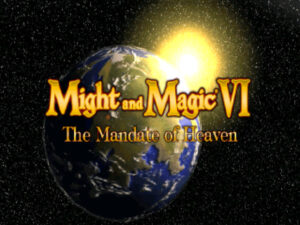
Might and Magic VI has nothing to do with the history of imperial China. The phrase “Mandate of Heaven” is used as its subtitle just because someone at New World thought it sounded cool. Pretty much everything else to be found in the game has the same justification.
Indeed, of all the games and series I’ll be discussing in these articles, the Might and Magic series was in some ways the closest in spirit to Diablo. This isn’t to say that the two were peas in a pod: just to begin the list of differences, those first five Might and Magic games were all turn-based rather than real-time, first-person rather than third-person, with hand-crafted rather than procedurally-generated dungeons and with far more complex and demanding systems to master, whilst quite possibly requiring an order of magnitude more hours for the average player to finish a single time. For all that, though, they did share with Diablo a strident ethic of fun as the final adjudicator. They had no interest in elaborate world-building or statement-making in the way of, say, the Ultima series. At heart, a Might and Magic game was a giant toy box, overflowing with challenges and affordances that could be engaged with in a nearly endless number of ways. Although a Might and Magic CRPG might not represent much of an argument for games as refined storytelling vehicles, much less as art, you were generally too busy messing with all the stuff you found inside it to care.
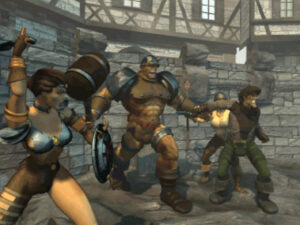
Do you remember me telling you that Fallout raised the bar of sophistication in CRPG aesthetics? You won’t catch me saying that today. Might and Magic VI’s aesthetic principles are pure, unadulterated teenage Dungeon Master.
Being himself not a particularly artsy guy, Jon Van Caneghem saw no reason to alter this philosophy for Might and Magic VI. Still, he was keenly aware that some things would have to change if the new game was to fit comfortably into a post-DOOM, post-Quake world. Like its predecessors, Might and Magic VI would be a first-person “blobber”: an entire party of characters under your control would be “blobbed” together into a sort of lethal octopus, with you the player staring out from the center of the writhing mass. The big difference with the sixth installment would be that the amalgamation would move about freely — i.e., DOOM (or Ultima Underworld) style — rather than over a step-wise grid of possible locations on the map.
That said, the engine used for Might and Magic VI was not anything to leave shooter fans of its era overly impressed. New World decided not to require or even support the new breed of 3D-graphics cards that were taking gaming by storm just as work on it was beginning. In retrospect, this decision was perhaps a questionable one. For it left Might and Magic VI’s visuals lagging miles behind the state of the art by the time of its eventual release in the spring of 1998; comparisons with Unreal, the latest shooter wunderkind on the block, did not redound to its benefit.
This is not to say that the graphics aren’t endearing. A willingness to be goofy was always intrinsic to the series’s personality. The pixelated environments and the monsters that sometimes look like cut-out dolls that have been pasted on top of a picture of their surroundings are part and parcel of that. If it looked more refined, it wouldn’t look like Might and Magic.
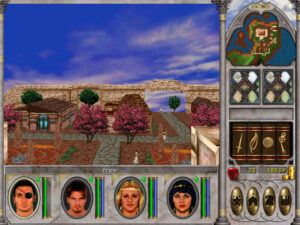
Was anything ever more late 1990s than these digitized character portraits? Xena: Warrior Princess called, asking for Lucy Lawless back.
As I mentioned when discussing Fallout, one of the hidden stumbling blocks for those who dreamed of resuscitating the CRPG was reconciling free-scrolling, real-time movement with the genre’s tradition of relatively complex, usually turn-based combat. I found Fallout’s approach more frustrating than satisfying; I’m therefore happy to say that I like what Might and Magic VI does much better. As with Fallout, there is a turn-based mode here that the game can slip in and out of. But there are two key differences. One is that you choose when to enter and exit the turn-based mode, by hitting — appropriately enough — the enter key. The other is that you can also fight in real-time mode if you like. In a lot of situations, doing so tends to get you killed in a hurry, but there are places, especially once you’ve built up your characters a bit, where you can run and gun almost as if you’re playing a first-person shooter. In turn-based mode, on the other hand, the game plays much like the Might and Magics of yore, except that your party is frozen in place; adjusting your position requires a quick trip in and out of real-time mode. It may sound a little wonky, but it all hangs together surprisingly well in practice. I find Might and Magic VI’s combat to be good fun, which is more than I can say for Fallout.
And it’s fortunate that I feel that way, because fighting monsters, preparing to fight monsters, and traveling to where monsters are waiting to be fought are what you spend most of your time doing. Might and Magic VI has none of Fallout’s ambitions to reinvent the CRPG as a more holistic sort of interactive narrative. It gives you a collection of blatantly artificial stage sets rather than a lived-in world, filled with non-player characters who function strictly as antagonists to slay, as irrelevant blank slates, or as quest-giving slot machines. Sure, there’s a story — in fact, a story that follows directly on from the main campaign in Heroes of Might and Magic II, representing an effort to integrate the two series in some other sense than their names, their bright and colorful visual aesthetics, and their epic-fantasy trappings. Evil forces are about to destroy the world of Enroth, and Archibald, the villain from Heroes II, is mixed up with them, but not in the way that you might think, and… You know what? I really can’t remember, even though I didn’t finish the game all that long ago. No, wait… I do remember that aliens turn out to be behind it all. This gives you the opportunity to run around shooting robots with lasers before all is said and done. As I mentioned, Might and Magic VI is never afraid to be goofy.
It’s weirdly freeing to play a game that so plainly answers only to the dictates of fun. Might and Magic VI is a monument to excess sufficient to make a Saudi prince blanch. Whenever I think about it, I remember Gary Gygax’s stern admonition against just this sort of thing in the first-edition Advanced Dungeons & Dragons Dungeon Master’s Guide, that staple work of literature of my generation’s nerdy youth.
Many campaigns are little more than a joke, something that better Dungeon Masters jape at and ridicule — rightly so on the surface — because of the foolishness of player characters with astronomically high levels of experience and no real playing skill. These godlike characters boast and strut about with retinues of ultra-powerful servants and scores of mighty magic items, artifacts, [and] relics adorning them as if they were Christmas trees decked out with tinsel and ornaments. Not only are such “Monty Haul” games a crashing bore for most participants, they are a headache for their Dungeon Masters as well…
Might and Magic VI is the perfect riposte for old Gary’s po-faced pronouncements. It lets you advance your characters to level 90 and beyond, by which time they pretty much are gods, able to teleport instantly from one side of a continent to the other and to cover shorter distances by flying high above the mountaintops, raining fiery death from the heavens upon any poor earthbound creatures who happen to be visible below. And you know what? It’s not boring at all. It’s actually kind of awesome. Like Diablo, Might and Magic VI zeroes in relentlessly on the lizard-brain appeal of its genre. We all like to watch the numbers associated with our characters go up and then go up some more, like to know that we’re more formidable today than we were yesterday. (If only real life worked like that…)
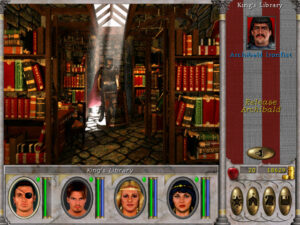
Is this really a good idea? Ah, don’t worry about it. This isn’t the sort of game that goes in for moral dilemmas. If it feels good, do it.
The world in which this progress narrative takes place may not be terribly believable even as fantasy goes, but it’s appropriately sprawling. The lovely, throwback cloth map that came in the original box contains no fewer than fifteen discrete regions that you can visit, each of them dauntingly large, full of towns and castles and roaming creatures and hidden and not-so-hidden curiosities, among them the entrances to multiple dungeons that are sometimes shockingly huge in themselves. Although I’m sure some of our modern DLC-fueled monstrosities have far surpassed it in size by now, Might and Magic VI might just be the biggest single CRPG that yours truly has ever played from start to finish.
The game was able to hold my interest for the 100 hours or more I spent with it by giving me so darn much to do. Every town has at least a few quests to see through. Sometimes these are related to the main story line, but more often they’re standalone. Each of the character classes can evolve into two more advanced incarnations of itself; an archer, for example, can become a “battle mage” and then a “warrior mage.” Doing so entails hunting down the necessary trainer and completing a quest for him or her. Your characters’ more granular skills, which encompass the expected schools of magic and types of weaponry alongside miscellaneous talents ranging from “Bodybuilding” to “Repair Item,” also require trainers in order to be advanced to “Expert” and then “Master” status. There’s always something to do, some goal to pursue, whether it’s provided by the game or one you made up for yourself: collect every single spell; pray at every shrine during the one month of the year when you get something out of it. Because there’s no complex plot whose own needs have to act as a check on your wanderings, it’s always you rather than the game who gets to decide what you do next. This world is truly your oyster — as long as you’re tough enough to take on the many and varied monsters that infest every corner of it that you enter, that is.
The toy-box quality of Might and Magic VI lets it get away with things that less sanguine, more self-serious peers would get dinged for. The jank in the engine — and make no mistake, there’s a lot of jank here — feels more like a feature than a bug when, say, you find just the right angle to stand in a doorway, the one that lets you whale away on a group of monsters while they for some reason can’t hit you. Fairly early in my play-through, I found myself in a sewer filled with living oozes that were impervious to weaponry and shot blobs of slime that were corrosive to armor. The sensible thing to do would have been to go away and come back later. Instead of being sensible, I found a stairway from whose top I could throw my one effective spell at the oozes while they were unable to hit me at all. I spent several evenings luring oozes from all over the sewer back to that killing floor, harvesting huge quantities of experience points from them. Sure, it was kind of tedious, but it was kind of great at the same time. Finding exploits like this — exploits that would undermine a less gonzo, more finely calibrated game — is just another part of the fun of Might and Magic VI. Everyone who’s ever played it seems to come away with her own list of favorite ways to break it.
I’m not even all that bothered that the game feels a little bit unfinished. As you play, you’ll probably find yourself exploring Enroth in an eastward to westward direction, which is all too clearly also the direction in which New World built their world. The last couple of regions you’re likely to visit, along the western edge of the map, are deserts filled with hordes of deadly dragons and not much else. It’s plain as day that New World was running out of gas by the time they got this far. But, in light of all they had already put into their world by this point, it’s hard to begrudge them the threadbare westerly regions too much. I’m well aware that I’m not usually so kind toward such failures to stick the landing; this is the place where I usually start muttering about the need for a work to be complete in an “Aristotelian sense” and all the rest. Never fear; we’ll doubtless return to such pretensions in future articles. But in the case of a joyously goofy, loosey-goosey epic like Might and Magic VI… well, how much more of it do you really want? It’s just not a game to which Aristotelian symmetries apply.
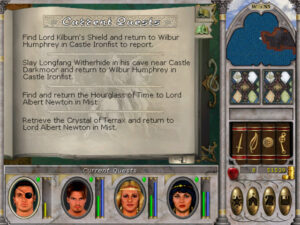
The game is old-school more in spirit than in execution. Among its welcome conveniences is a quest log that’s more reliably to-the-point than the one found in Fallout or even the later Baldur’s Gate. Its interface too is clean and easy to come to grips with, even today. Again, the same can’t be said of Fallout…
Might and Magic VI was released on April 30, 1998. This places it at almost the exact midpoint between Fallout, that first exemplar of a new breed of CRPGs in the offing, and the CRPGS that Interplay would publish near the end of 1998, which would serve to cement and consolidate Fallout’s innovations. For its part, Might and Magic VI can be seen as a bridge between the old ways and the new. In spirit, it’s defiantly old-school. Yet there are enough new features and conveniences — including not just the free-scrolling movement and optional real-time combat, but also such niceties as a quest log, a superb auto-map, and a raft of other information-management functions — to mark it out as a product of 1998 rather than 1988 or even 1993. It sold 125,000 copies in the United States alone, enough to justify Jon Van Caneghem’s risky decision to take a chance on it in the midst of the driest period of the CRPG drought. And its success was well deserved. Few latter-day installments of any series have done as good a job of ratcheting up their accessibility whilst retaining the essence of what made their predecessors popular.
For all their vast differences in form and spirit, aesthetics and gameplay, Diablo, Fallout, and Might and Magic VI together left gamers more excited about the CRPG genre in general than they had been in years. Interplay was now preparing to seize that opportunity. Ten years after the much-celebrated Pool of Radiance, Brian Fargo and company, working in concert with a card-game publisher called Wizards of the Coast, were preparing Dungeons & Dragons for a brand-new star turn. The first mover of the RPG was about to get its mojo back.
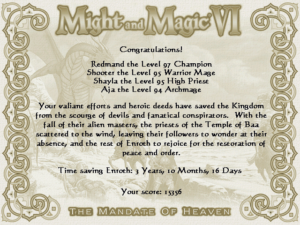
I played Might and Magic VI for 100 hours, and all I got was this lousy certificate. Am I proud of my achievement? Maybe just a little…
Did you enjoy this article? If so, please think about pitching in to help me make many more like it. You can pledge any amount you like.
Sources: The book Gamers at Work: Stories Behind the Games People Play by Morgan Ramsay and Advanced D&D: Dungeon Master’s Guide by Gary Gygax. Computer Gaming World of October 1997, June 1998, August 1998, and April 2004; Retro Gamer 49; XRDS: The ACM Magazine for Students of Summer 2017.
Online sources include Matt Barton’s interview with Jon Van Caneghem, the RPG Codex interview with Jon Van Caneghem, the Arcade Attack interview with Trip Hawkins, and “Trip’s Big Interactive Reset” by Ernie Smith at Tedium.
Where to Get It: The first six Might and Magic CRPGs are available as a single digital purchase from GOG.com. What a deal!
Footnotes
| ↑1 | The game was known as UFO: Enemy Unknown in its British homeland and elsewhere in Europe. |
|---|
